Marketing Essentials: A Comprehensive Analysis of Toyota's Marketing Strategies
VerifiedAdded on 2024/05/30
|21
|4758
|182
AI Summary
This report delves into the fundamental aspects of marketing, exploring its role within an organization and its interrelation with other functional units. It examines how Toyota, a leading automotive manufacturer, utilizes the marketing mix (7Ps) to achieve its business objectives. The report further analyzes Toyota's marketing plan, including its vision, objectives, target markets, and strategies for success. By comparing Toyota's marketing mix with that of its competitor, Honda, the report provides a comprehensive understanding of the company's strengths and weaknesses in the competitive landscape.
Contribute Materials
Your contribution can guide someone’s learning journey. Share your
documents today.
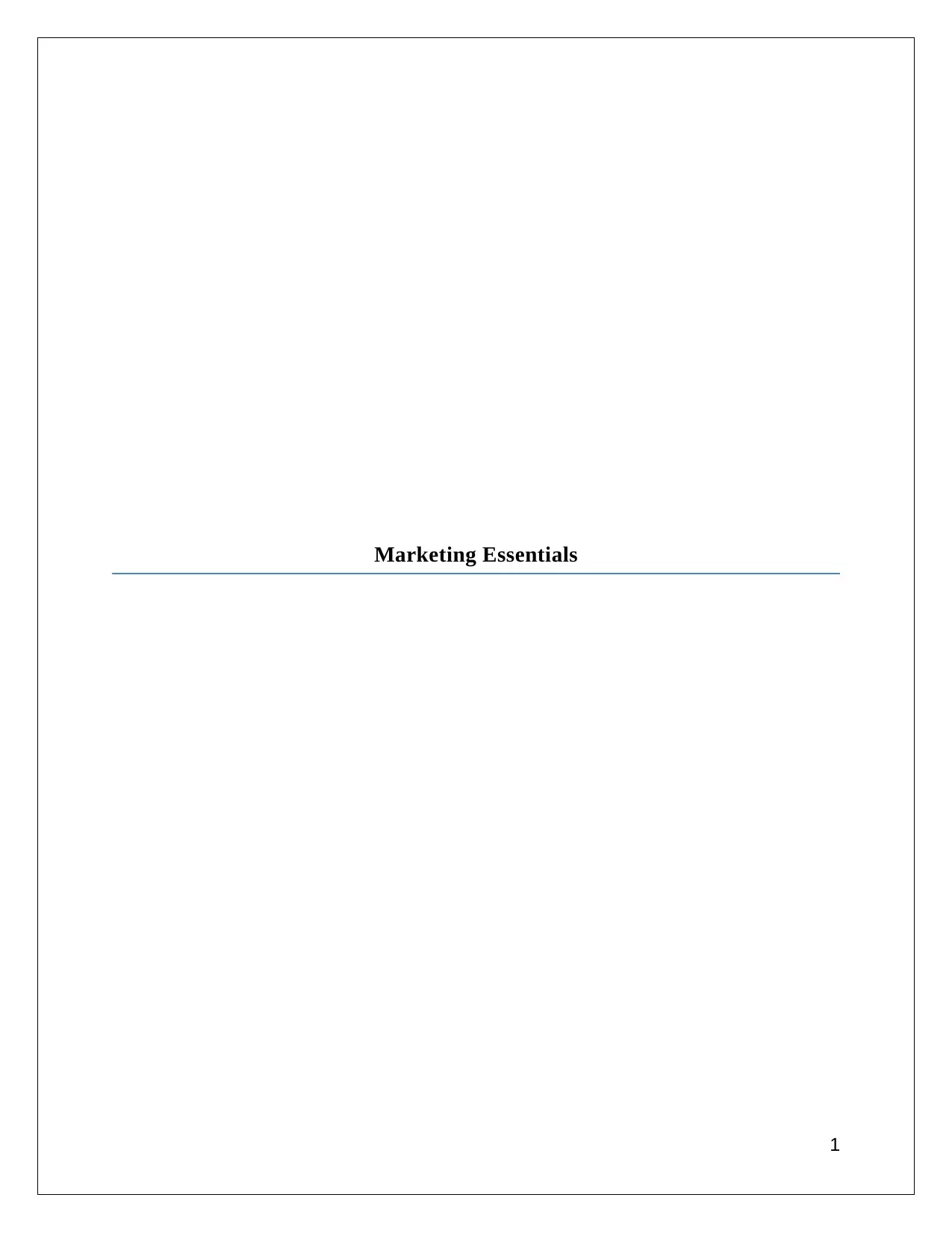
Marketing Essentials
1
1
Secure Best Marks with AI Grader
Need help grading? Try our AI Grader for instant feedback on your assignments.
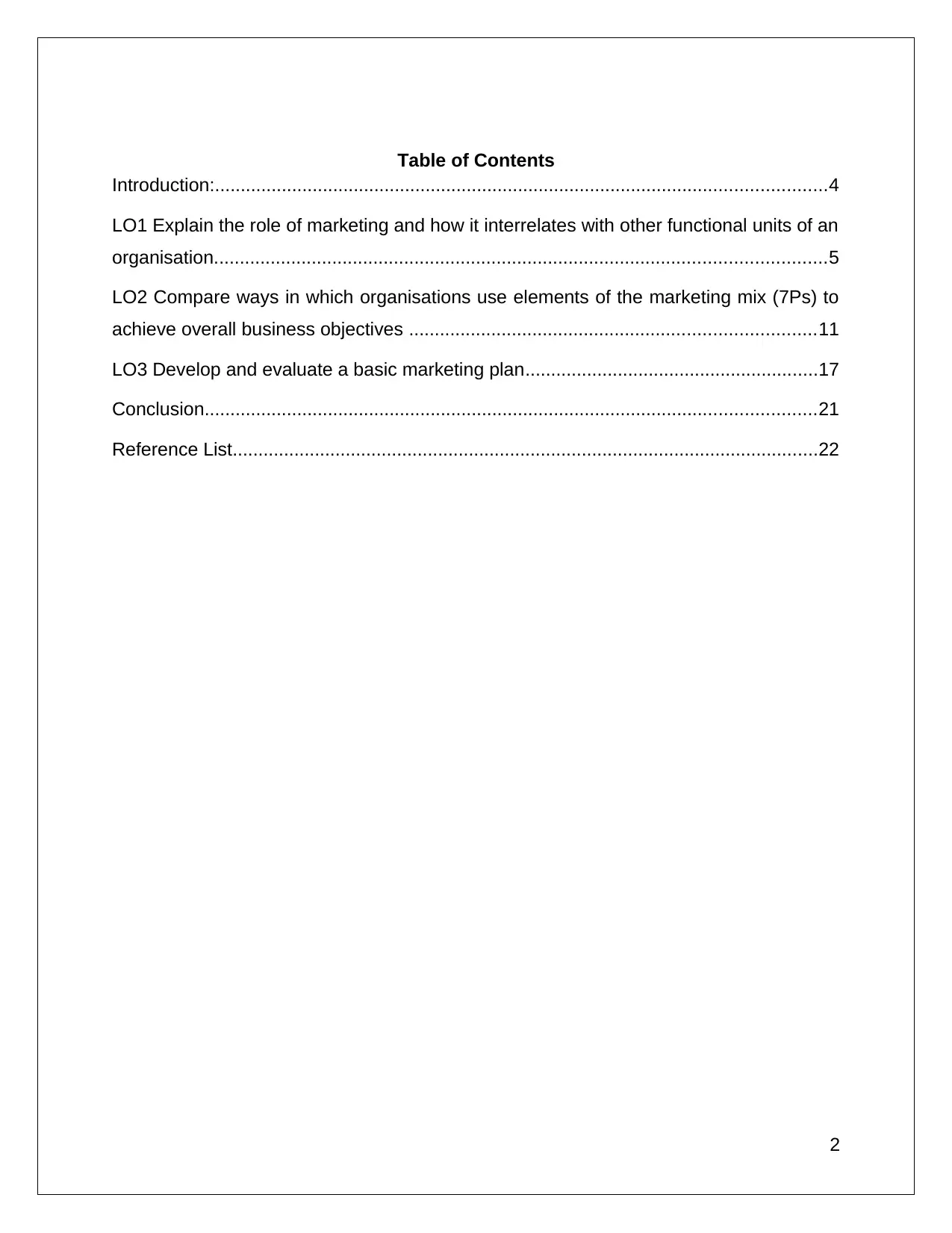
Table of Contents
Introduction:.......................................................................................................................4
LO1 Explain the role of marketing and how it interrelates with other functional units of an
organisation.......................................................................................................................5
LO2 Compare ways in which organisations use elements of the marketing mix (7Ps) to
achieve overall business objectives ...............................................................................11
LO3 Develop and evaluate a basic marketing plan.........................................................17
Conclusion.......................................................................................................................21
Reference List..................................................................................................................22
2
Introduction:.......................................................................................................................4
LO1 Explain the role of marketing and how it interrelates with other functional units of an
organisation.......................................................................................................................5
LO2 Compare ways in which organisations use elements of the marketing mix (7Ps) to
achieve overall business objectives ...............................................................................11
LO3 Develop and evaluate a basic marketing plan.........................................................17
Conclusion.......................................................................................................................21
Reference List..................................................................................................................22
2
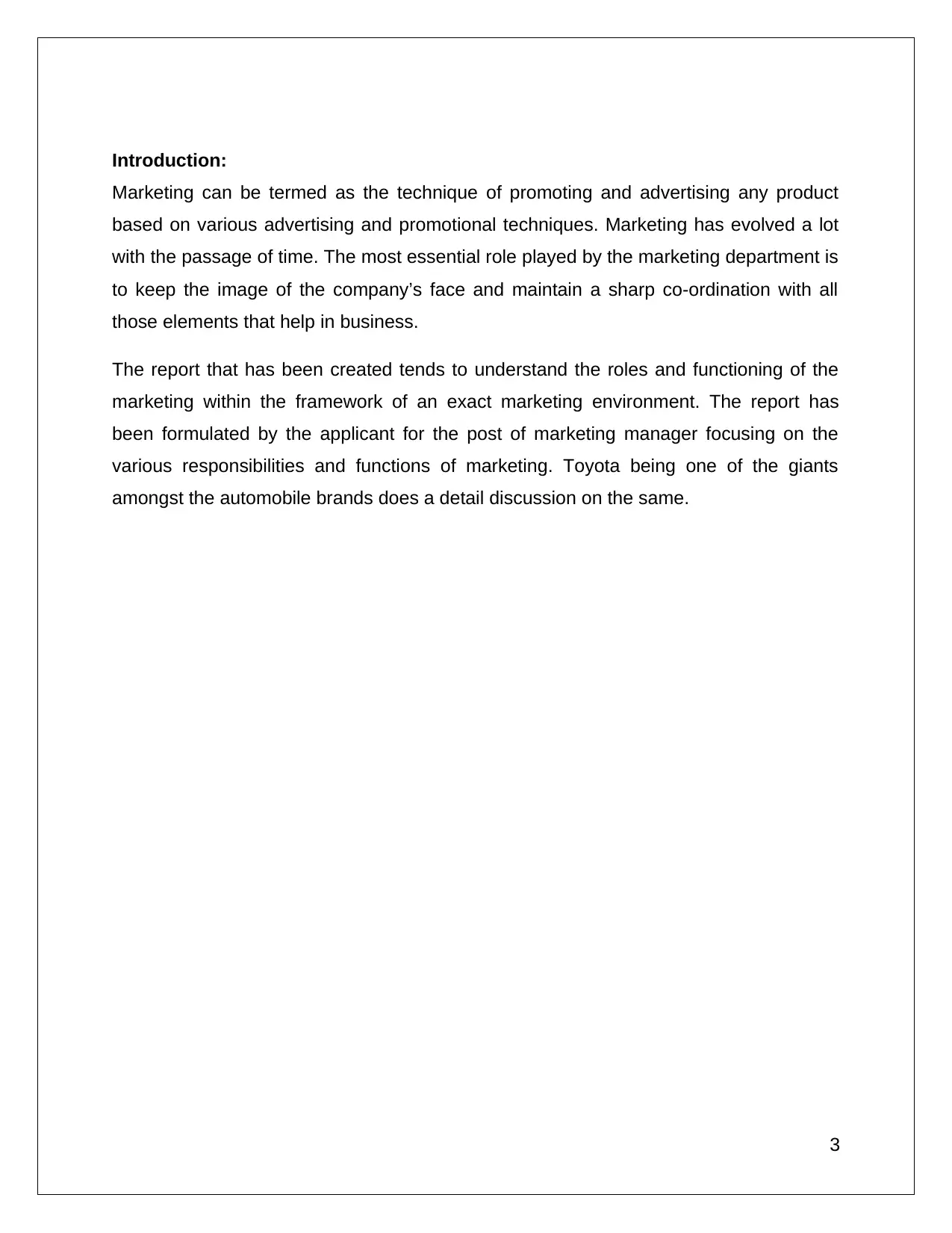
Introduction:
Marketing can be termed as the technique of promoting and advertising any product
based on various advertising and promotional techniques. Marketing has evolved a lot
with the passage of time. The most essential role played by the marketing department is
to keep the image of the company’s face and maintain a sharp co-ordination with all
those elements that help in business.
The report that has been created tends to understand the roles and functioning of the
marketing within the framework of an exact marketing environment. The report has
been formulated by the applicant for the post of marketing manager focusing on the
various responsibilities and functions of marketing. Toyota being one of the giants
amongst the automobile brands does a detail discussion on the same.
3
Marketing can be termed as the technique of promoting and advertising any product
based on various advertising and promotional techniques. Marketing has evolved a lot
with the passage of time. The most essential role played by the marketing department is
to keep the image of the company’s face and maintain a sharp co-ordination with all
those elements that help in business.
The report that has been created tends to understand the roles and functioning of the
marketing within the framework of an exact marketing environment. The report has
been formulated by the applicant for the post of marketing manager focusing on the
various responsibilities and functions of marketing. Toyota being one of the giants
amongst the automobile brands does a detail discussion on the same.
3
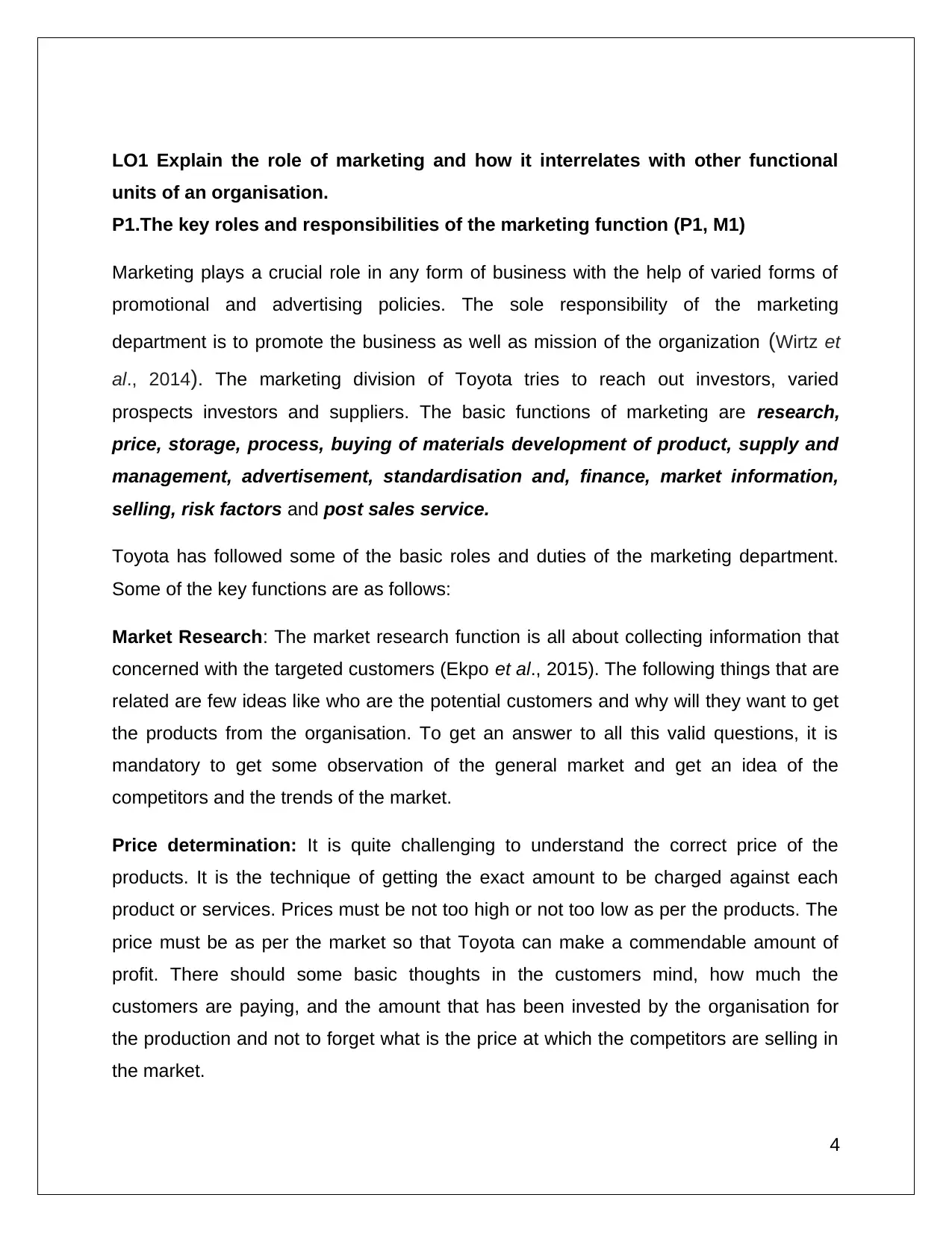
LO1 Explain the role of marketing and how it interrelates with other functional
units of an organisation.
P1.The key roles and responsibilities of the marketing function (P1, M1)
Marketing plays a crucial role in any form of business with the help of varied forms of
promotional and advertising policies. The sole responsibility of the marketing
department is to promote the business as well as mission of the organization (Wirtz et
al., 2014). The marketing division of Toyota tries to reach out investors, varied
prospects investors and suppliers. The basic functions of marketing are research,
price, storage, process, buying of materials development of product, supply and
management, advertisement, standardisation and, finance, market information,
selling, risk factors and post sales service.
Toyota has followed some of the basic roles and duties of the marketing department.
Some of the key functions are as follows:
Market Research: The market research function is all about collecting information that
concerned with the targeted customers (Ekpo et al., 2015). The following things that are
related are few ideas like who are the potential customers and why will they want to get
the products from the organisation. To get an answer to all this valid questions, it is
mandatory to get some observation of the general market and get an idea of the
competitors and the trends of the market.
Price determination: It is quite challenging to understand the correct price of the
products. It is the technique of getting the exact amount to be charged against each
product or services. Prices must be not too high or not too low as per the products. The
price must be as per the market so that Toyota can make a commendable amount of
profit. There should some basic thoughts in the customers mind, how much the
customers are paying, and the amount that has been invested by the organisation for
the production and not to forget what is the price at which the competitors are selling in
the market.
4
units of an organisation.
P1.The key roles and responsibilities of the marketing function (P1, M1)
Marketing plays a crucial role in any form of business with the help of varied forms of
promotional and advertising policies. The sole responsibility of the marketing
department is to promote the business as well as mission of the organization (Wirtz et
al., 2014). The marketing division of Toyota tries to reach out investors, varied
prospects investors and suppliers. The basic functions of marketing are research,
price, storage, process, buying of materials development of product, supply and
management, advertisement, standardisation and, finance, market information,
selling, risk factors and post sales service.
Toyota has followed some of the basic roles and duties of the marketing department.
Some of the key functions are as follows:
Market Research: The market research function is all about collecting information that
concerned with the targeted customers (Ekpo et al., 2015). The following things that are
related are few ideas like who are the potential customers and why will they want to get
the products from the organisation. To get an answer to all this valid questions, it is
mandatory to get some observation of the general market and get an idea of the
competitors and the trends of the market.
Price determination: It is quite challenging to understand the correct price of the
products. It is the technique of getting the exact amount to be charged against each
product or services. Prices must be not too high or not too low as per the products. The
price must be as per the market so that Toyota can make a commendable amount of
profit. There should some basic thoughts in the customers mind, how much the
customers are paying, and the amount that has been invested by the organisation for
the production and not to forget what is the price at which the competitors are selling in
the market.
4
Secure Best Marks with AI Grader
Need help grading? Try our AI Grader for instant feedback on your assignments.
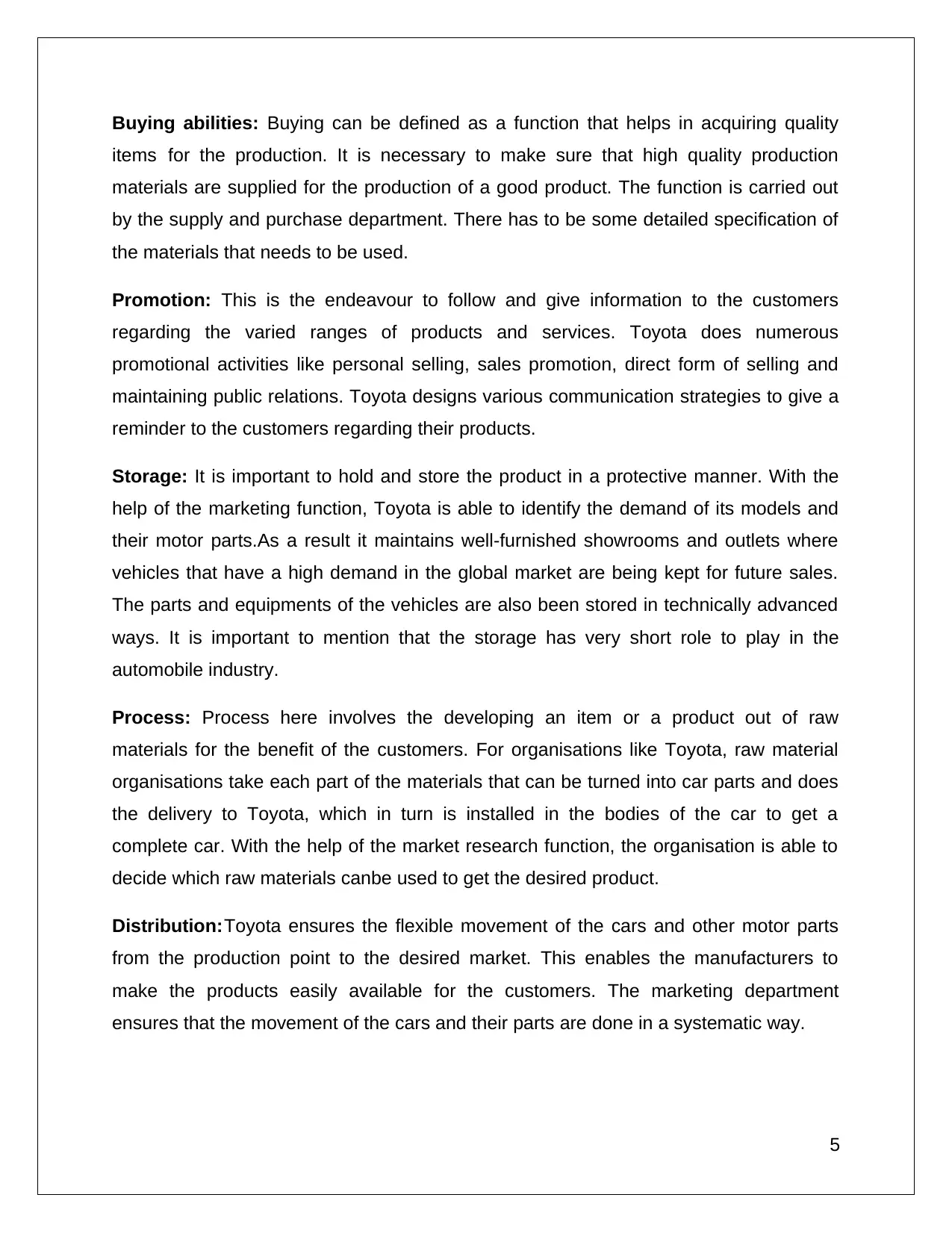
Buying abilities: Buying can be defined as a function that helps in acquiring quality
items for the production. It is necessary to make sure that high quality production
materials are supplied for the production of a good product. The function is carried out
by the supply and purchase department. There has to be some detailed specification of
the materials that needs to be used.
Promotion: This is the endeavour to follow and give information to the customers
regarding the varied ranges of products and services. Toyota does numerous
promotional activities like personal selling, sales promotion, direct form of selling and
maintaining public relations. Toyota designs various communication strategies to give a
reminder to the customers regarding their products.
Storage: It is important to hold and store the product in a protective manner. With the
help of the marketing function, Toyota is able to identify the demand of its models and
their motor parts.As a result it maintains well-furnished showrooms and outlets where
vehicles that have a high demand in the global market are being kept for future sales.
The parts and equipments of the vehicles are also been stored in technically advanced
ways. It is important to mention that the storage has very short role to play in the
automobile industry.
Process: Process here involves the developing an item or a product out of raw
materials for the benefit of the customers. For organisations like Toyota, raw material
organisations take each part of the materials that can be turned into car parts and does
the delivery to Toyota, which in turn is installed in the bodies of the car to get a
complete car. With the help of the market research function, the organisation is able to
decide which raw materials canbe used to get the desired product.
Distribution:Toyota ensures the flexible movement of the cars and other motor parts
from the production point to the desired market. This enables the manufacturers to
make the products easily available for the customers. The marketing department
ensures that the movement of the cars and their parts are done in a systematic way.
5
items for the production. It is necessary to make sure that high quality production
materials are supplied for the production of a good product. The function is carried out
by the supply and purchase department. There has to be some detailed specification of
the materials that needs to be used.
Promotion: This is the endeavour to follow and give information to the customers
regarding the varied ranges of products and services. Toyota does numerous
promotional activities like personal selling, sales promotion, direct form of selling and
maintaining public relations. Toyota designs various communication strategies to give a
reminder to the customers regarding their products.
Storage: It is important to hold and store the product in a protective manner. With the
help of the marketing function, Toyota is able to identify the demand of its models and
their motor parts.As a result it maintains well-furnished showrooms and outlets where
vehicles that have a high demand in the global market are being kept for future sales.
The parts and equipments of the vehicles are also been stored in technically advanced
ways. It is important to mention that the storage has very short role to play in the
automobile industry.
Process: Process here involves the developing an item or a product out of raw
materials for the benefit of the customers. For organisations like Toyota, raw material
organisations take each part of the materials that can be turned into car parts and does
the delivery to Toyota, which in turn is installed in the bodies of the car to get a
complete car. With the help of the market research function, the organisation is able to
decide which raw materials canbe used to get the desired product.
Distribution:Toyota ensures the flexible movement of the cars and other motor parts
from the production point to the desired market. This enables the manufacturers to
make the products easily available for the customers. The marketing department
ensures that the movement of the cars and their parts are done in a systematic way.
5
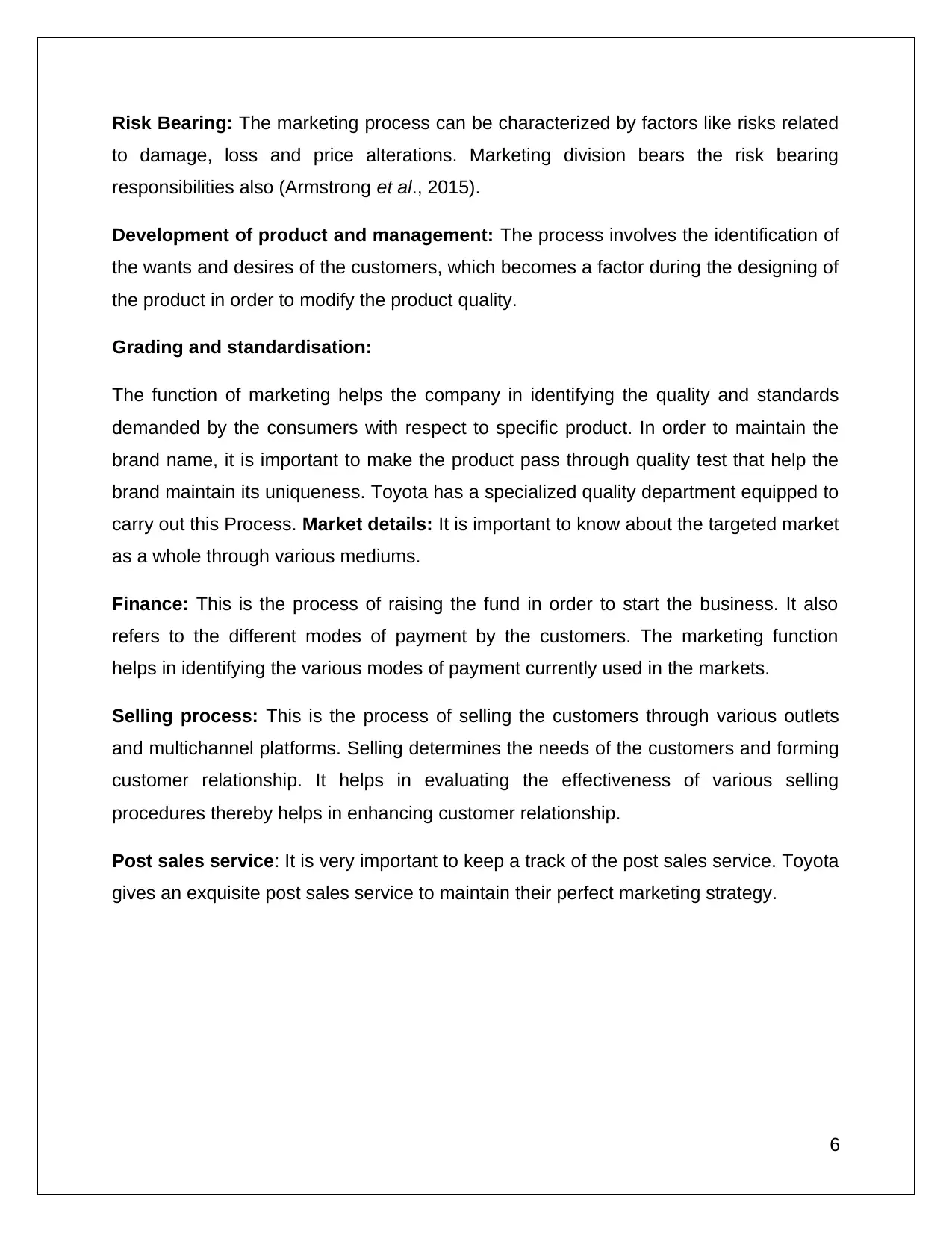
Risk Bearing: The marketing process can be characterized by factors like risks related
to damage, loss and price alterations. Marketing division bears the risk bearing
responsibilities also (Armstrong et al., 2015).
Development of product and management: The process involves the identification of
the wants and desires of the customers, which becomes a factor during the designing of
the product in order to modify the product quality.
Grading and standardisation:
The function of marketing helps the company in identifying the quality and standards
demanded by the consumers with respect to specific product. In order to maintain the
brand name, it is important to make the product pass through quality test that help the
brand maintain its uniqueness. Toyota has a specialized quality department equipped to
carry out this Process. Market details: It is important to know about the targeted market
as a whole through various mediums.
Finance: This is the process of raising the fund in order to start the business. It also
refers to the different modes of payment by the customers. The marketing function
helps in identifying the various modes of payment currently used in the markets.
Selling process: This is the process of selling the customers through various outlets
and multichannel platforms. Selling determines the needs of the customers and forming
customer relationship. It helps in evaluating the effectiveness of various selling
procedures thereby helps in enhancing customer relationship.
Post sales service: It is very important to keep a track of the post sales service. Toyota
gives an exquisite post sales service to maintain their perfect marketing strategy.
6
to damage, loss and price alterations. Marketing division bears the risk bearing
responsibilities also (Armstrong et al., 2015).
Development of product and management: The process involves the identification of
the wants and desires of the customers, which becomes a factor during the designing of
the product in order to modify the product quality.
Grading and standardisation:
The function of marketing helps the company in identifying the quality and standards
demanded by the consumers with respect to specific product. In order to maintain the
brand name, it is important to make the product pass through quality test that help the
brand maintain its uniqueness. Toyota has a specialized quality department equipped to
carry out this Process. Market details: It is important to know about the targeted market
as a whole through various mediums.
Finance: This is the process of raising the fund in order to start the business. It also
refers to the different modes of payment by the customers. The marketing function
helps in identifying the various modes of payment currently used in the markets.
Selling process: This is the process of selling the customers through various outlets
and multichannel platforms. Selling determines the needs of the customers and forming
customer relationship. It helps in evaluating the effectiveness of various selling
procedures thereby helps in enhancing customer relationship.
Post sales service: It is very important to keep a track of the post sales service. Toyota
gives an exquisite post sales service to maintain their perfect marketing strategy.
6
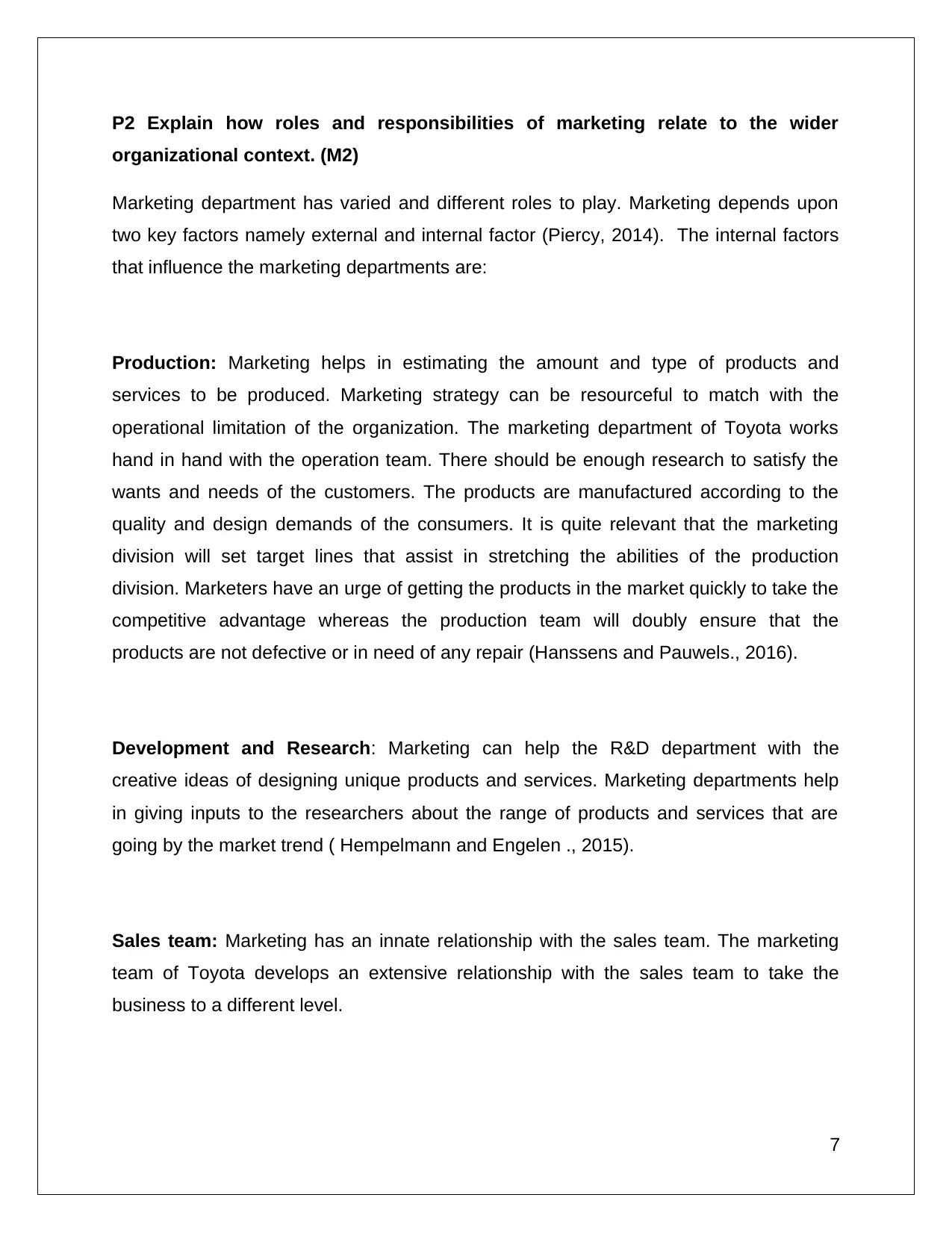
P2 Explain how roles and responsibilities of marketing relate to the wider
organizational context. (M2)
Marketing department has varied and different roles to play. Marketing depends upon
two key factors namely external and internal factor (Piercy, 2014). The internal factors
that influence the marketing departments are:
Production: Marketing helps in estimating the amount and type of products and
services to be produced. Marketing strategy can be resourceful to match with the
operational limitation of the organization. The marketing department of Toyota works
hand in hand with the operation team. There should be enough research to satisfy the
wants and needs of the customers. The products are manufactured according to the
quality and design demands of the consumers. It is quite relevant that the marketing
division will set target lines that assist in stretching the abilities of the production
division. Marketers have an urge of getting the products in the market quickly to take the
competitive advantage whereas the production team will doubly ensure that the
products are not defective or in need of any repair (Hanssens and Pauwels., 2016).
Development and Research: Marketing can help the R&D department with the
creative ideas of designing unique products and services. Marketing departments help
in giving inputs to the researchers about the range of products and services that are
going by the market trend ( Hempelmann and Engelen ., 2015).
Sales team: Marketing has an innate relationship with the sales team. The marketing
team of Toyota develops an extensive relationship with the sales team to take the
business to a different level.
7
organizational context. (M2)
Marketing department has varied and different roles to play. Marketing depends upon
two key factors namely external and internal factor (Piercy, 2014). The internal factors
that influence the marketing departments are:
Production: Marketing helps in estimating the amount and type of products and
services to be produced. Marketing strategy can be resourceful to match with the
operational limitation of the organization. The marketing department of Toyota works
hand in hand with the operation team. There should be enough research to satisfy the
wants and needs of the customers. The products are manufactured according to the
quality and design demands of the consumers. It is quite relevant that the marketing
division will set target lines that assist in stretching the abilities of the production
division. Marketers have an urge of getting the products in the market quickly to take the
competitive advantage whereas the production team will doubly ensure that the
products are not defective or in need of any repair (Hanssens and Pauwels., 2016).
Development and Research: Marketing can help the R&D department with the
creative ideas of designing unique products and services. Marketing departments help
in giving inputs to the researchers about the range of products and services that are
going by the market trend ( Hempelmann and Engelen ., 2015).
Sales team: Marketing has an innate relationship with the sales team. The marketing
team of Toyota develops an extensive relationship with the sales team to take the
business to a different level.
7
Paraphrase This Document
Need a fresh take? Get an instant paraphrase of this document with our AI Paraphraser
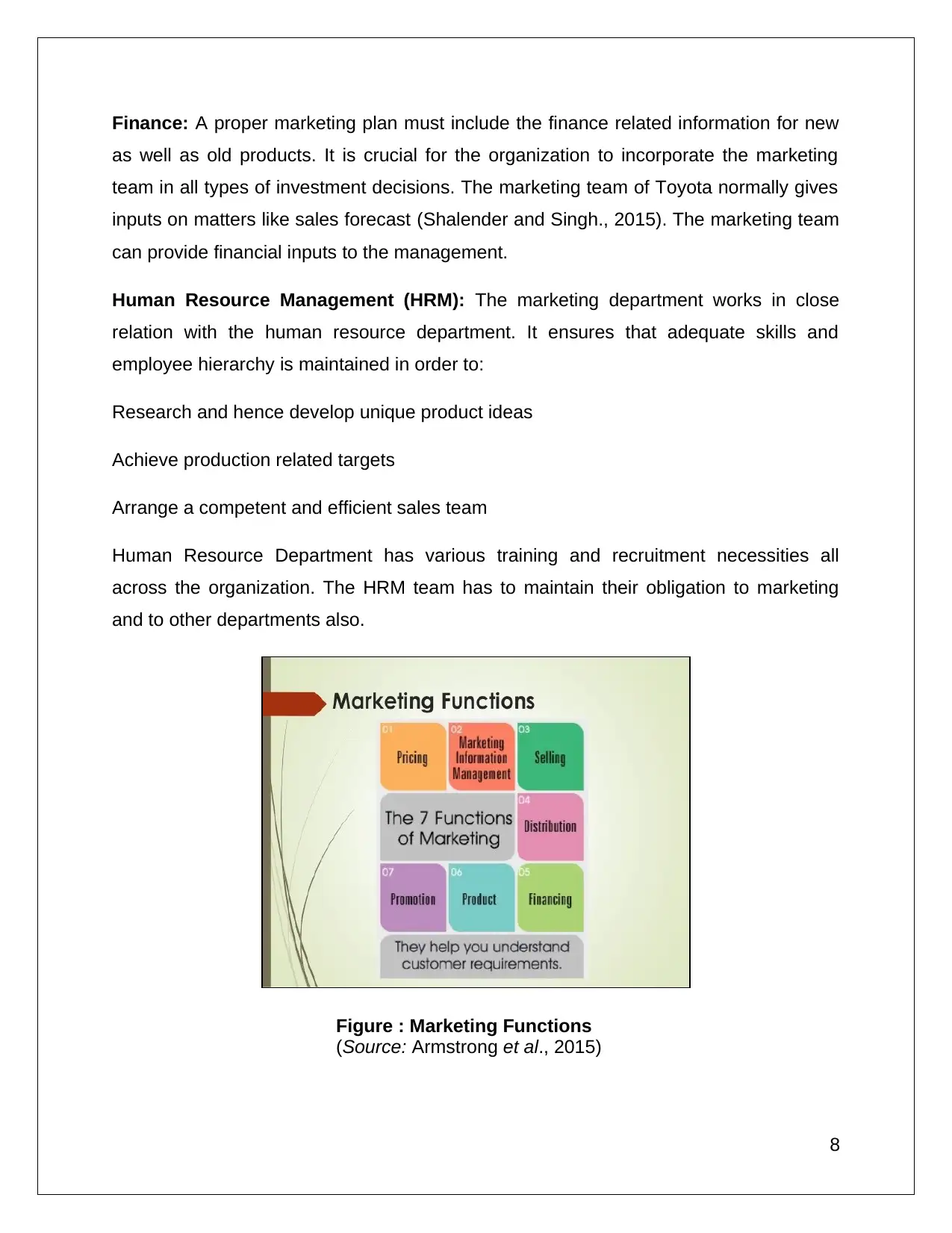
Finance: A proper marketing plan must include the finance related information for new
as well as old products. It is crucial for the organization to incorporate the marketing
team in all types of investment decisions. The marketing team of Toyota normally gives
inputs on matters like sales forecast (Shalender and Singh., 2015). The marketing team
can provide financial inputs to the management.
Human Resource Management (HRM): The marketing department works in close
relation with the human resource department. It ensures that adequate skills and
employee hierarchy is maintained in order to:
Research and hence develop unique product ideas
Achieve production related targets
Arrange a competent and efficient sales team
Human Resource Department has various training and recruitment necessities all
across the organization. The HRM team has to maintain their obligation to marketing
and to other departments also.
Figure : Marketing Functions
(Source: Armstrong et al., 2015)
8
as well as old products. It is crucial for the organization to incorporate the marketing
team in all types of investment decisions. The marketing team of Toyota normally gives
inputs on matters like sales forecast (Shalender and Singh., 2015). The marketing team
can provide financial inputs to the management.
Human Resource Management (HRM): The marketing department works in close
relation with the human resource department. It ensures that adequate skills and
employee hierarchy is maintained in order to:
Research and hence develop unique product ideas
Achieve production related targets
Arrange a competent and efficient sales team
Human Resource Department has various training and recruitment necessities all
across the organization. The HRM team has to maintain their obligation to marketing
and to other departments also.
Figure : Marketing Functions
(Source: Armstrong et al., 2015)
8
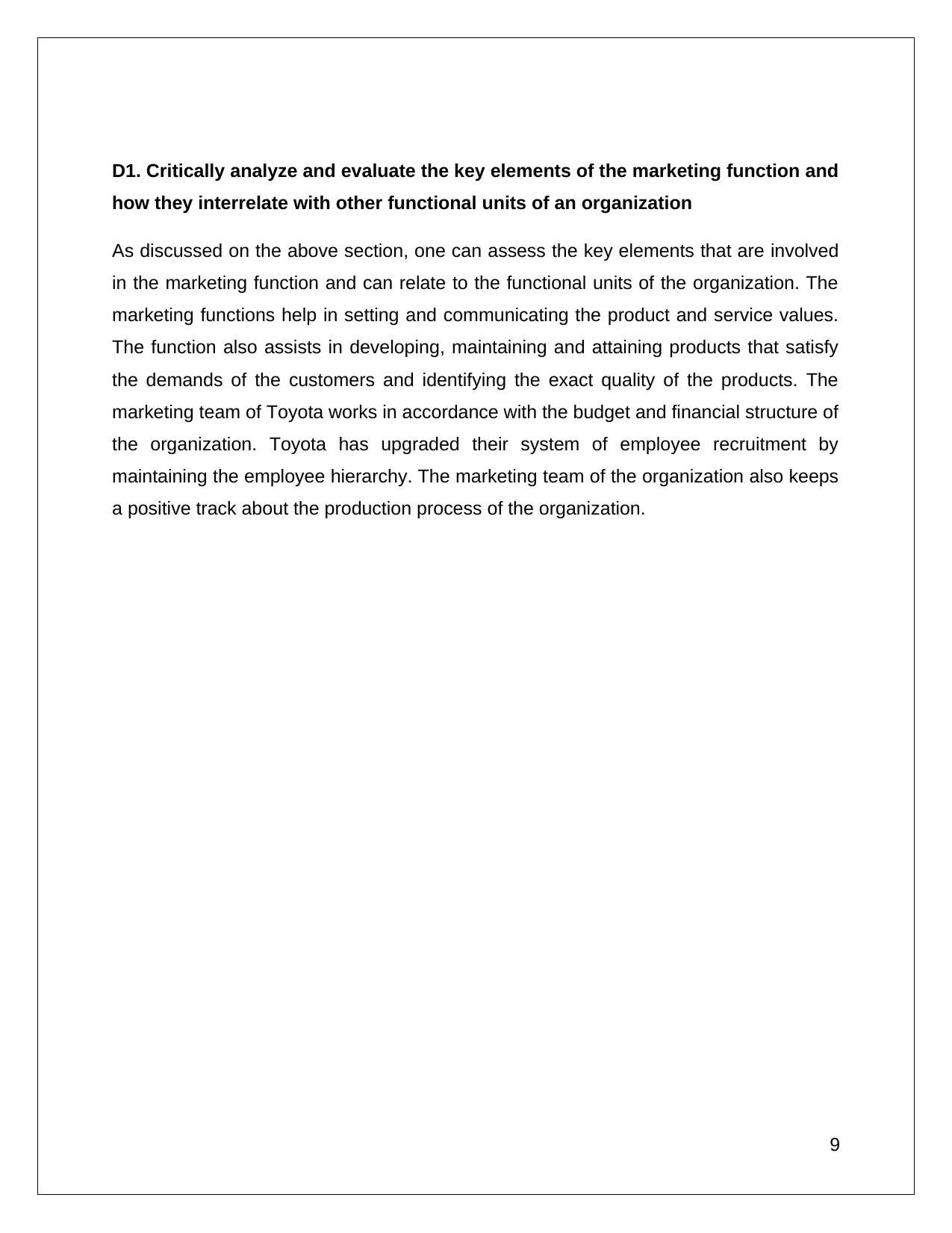
D1. Critically analyze and evaluate the key elements of the marketing function and
how they interrelate with other functional units of an organization
As discussed on the above section, one can assess the key elements that are involved
in the marketing function and can relate to the functional units of the organization. The
marketing functions help in setting and communicating the product and service values.
The function also assists in developing, maintaining and attaining products that satisfy
the demands of the customers and identifying the exact quality of the products. The
marketing team of Toyota works in accordance with the budget and financial structure of
the organization. Toyota has upgraded their system of employee recruitment by
maintaining the employee hierarchy. The marketing team of the organization also keeps
a positive track about the production process of the organization.
9
how they interrelate with other functional units of an organization
As discussed on the above section, one can assess the key elements that are involved
in the marketing function and can relate to the functional units of the organization. The
marketing functions help in setting and communicating the product and service values.
The function also assists in developing, maintaining and attaining products that satisfy
the demands of the customers and identifying the exact quality of the products. The
marketing team of Toyota works in accordance with the budget and financial structure of
the organization. Toyota has upgraded their system of employee recruitment by
maintaining the employee hierarchy. The marketing team of the organization also keeps
a positive track about the production process of the organization.
9
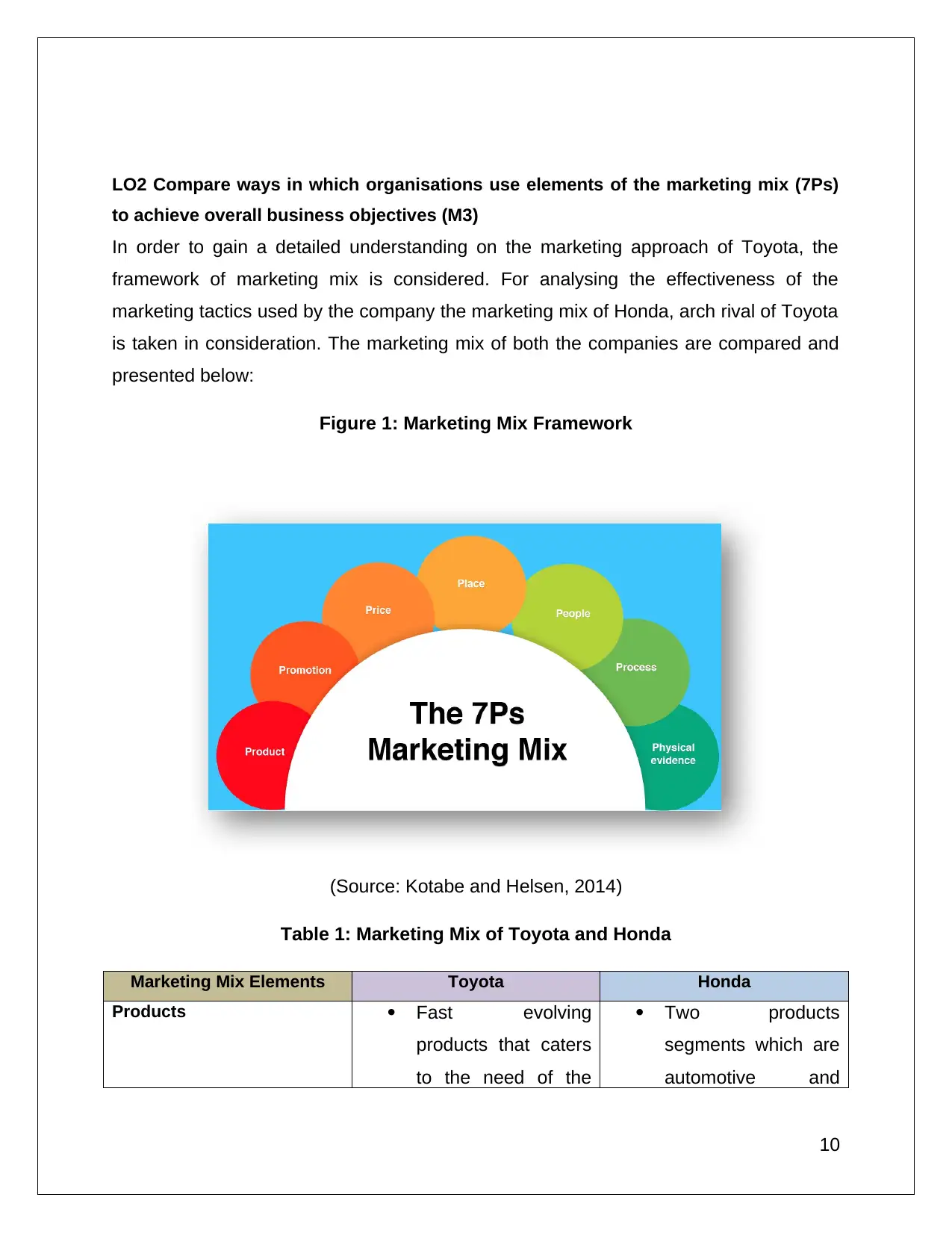
LO2 Compare ways in which organisations use elements of the marketing mix (7Ps)
to achieve overall business objectives (M3)
In order to gain a detailed understanding on the marketing approach of Toyota, the
framework of marketing mix is considered. For analysing the effectiveness of the
marketing tactics used by the company the marketing mix of Honda, arch rival of Toyota
is taken in consideration. The marketing mix of both the companies are compared and
presented below:
Figure 1: Marketing Mix Framework
(Source: Kotabe and Helsen, 2014)
Table 1: Marketing Mix of Toyota and Honda
Marketing Mix Elements Toyota Honda
Products Fast evolving
products that caters
to the need of the
Two products
segments which are
automotive and
10
to achieve overall business objectives (M3)
In order to gain a detailed understanding on the marketing approach of Toyota, the
framework of marketing mix is considered. For analysing the effectiveness of the
marketing tactics used by the company the marketing mix of Honda, arch rival of Toyota
is taken in consideration. The marketing mix of both the companies are compared and
presented below:
Figure 1: Marketing Mix Framework
(Source: Kotabe and Helsen, 2014)
Table 1: Marketing Mix of Toyota and Honda
Marketing Mix Elements Toyota Honda
Products Fast evolving
products that caters
to the need of the
Two products
segments which are
automotive and
10
Secure Best Marks with AI Grader
Need help grading? Try our AI Grader for instant feedback on your assignments.
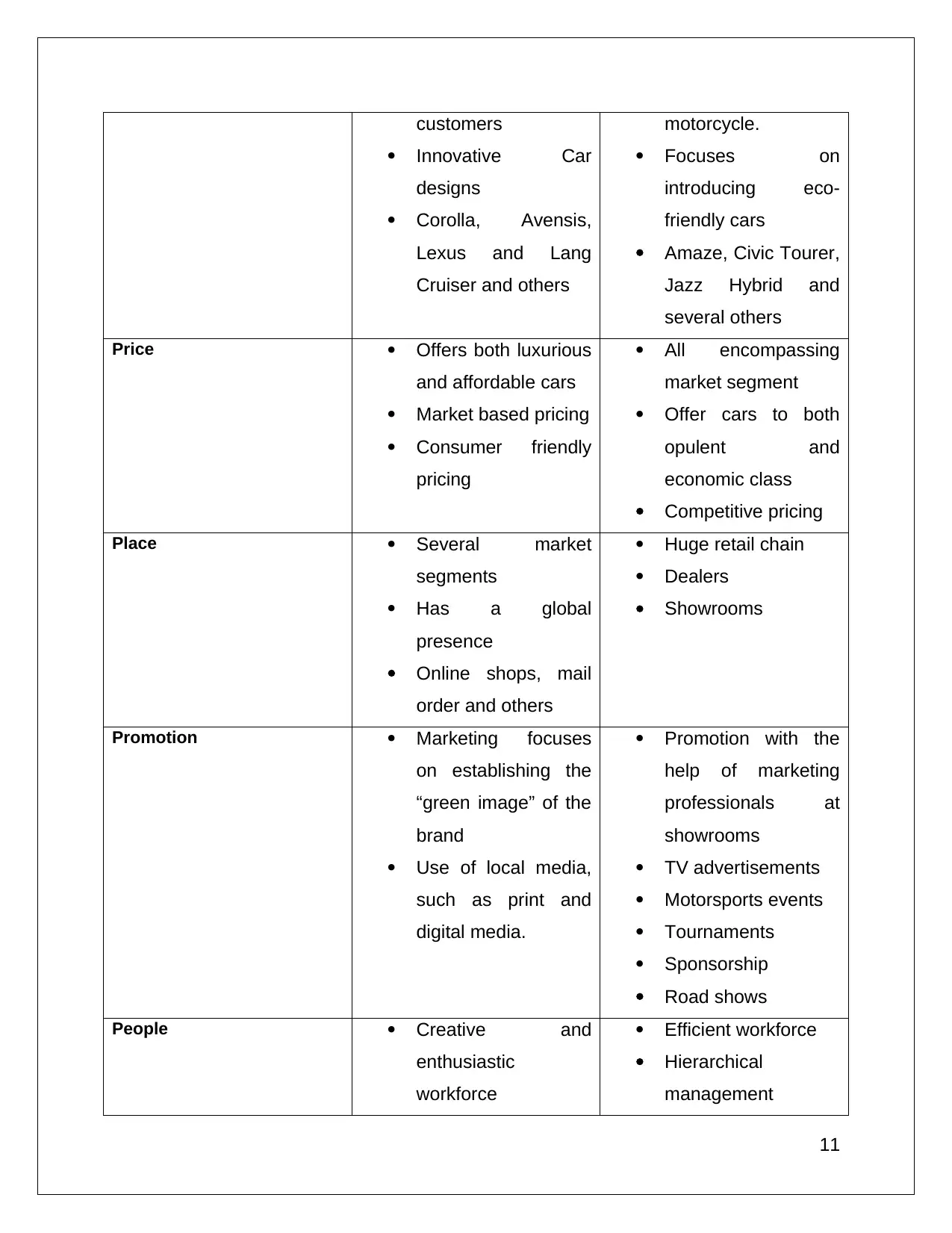
customers
Innovative Car
designs
Corolla, Avensis,
Lexus and Lang
Cruiser and others
motorcycle.
Focuses on
introducing eco-
friendly cars
Amaze, Civic Tourer,
Jazz Hybrid and
several others
Price Offers both luxurious
and affordable cars
Market based pricing
Consumer friendly
pricing
All encompassing
market segment
Offer cars to both
opulent and
economic class
Competitive pricing
Place Several market
segments
Has a global
presence
Online shops, mail
order and others
Huge retail chain
Dealers
Showrooms
Promotion Marketing focuses
on establishing the
“green image” of the
brand
Use of local media,
such as print and
digital media.
Promotion with the
help of marketing
professionals at
showrooms
TV advertisements
Motorsports events
Tournaments
Sponsorship
Road shows
People Creative and
enthusiastic
workforce
Efficient workforce
Hierarchical
management
11
Innovative Car
designs
Corolla, Avensis,
Lexus and Lang
Cruiser and others
motorcycle.
Focuses on
introducing eco-
friendly cars
Amaze, Civic Tourer,
Jazz Hybrid and
several others
Price Offers both luxurious
and affordable cars
Market based pricing
Consumer friendly
pricing
All encompassing
market segment
Offer cars to both
opulent and
economic class
Competitive pricing
Place Several market
segments
Has a global
presence
Online shops, mail
order and others
Huge retail chain
Dealers
Showrooms
Promotion Marketing focuses
on establishing the
“green image” of the
brand
Use of local media,
such as print and
digital media.
Promotion with the
help of marketing
professionals at
showrooms
TV advertisements
Motorsports events
Tournaments
Sponsorship
Road shows
People Creative and
enthusiastic
workforce
Efficient workforce
Hierarchical
management
11
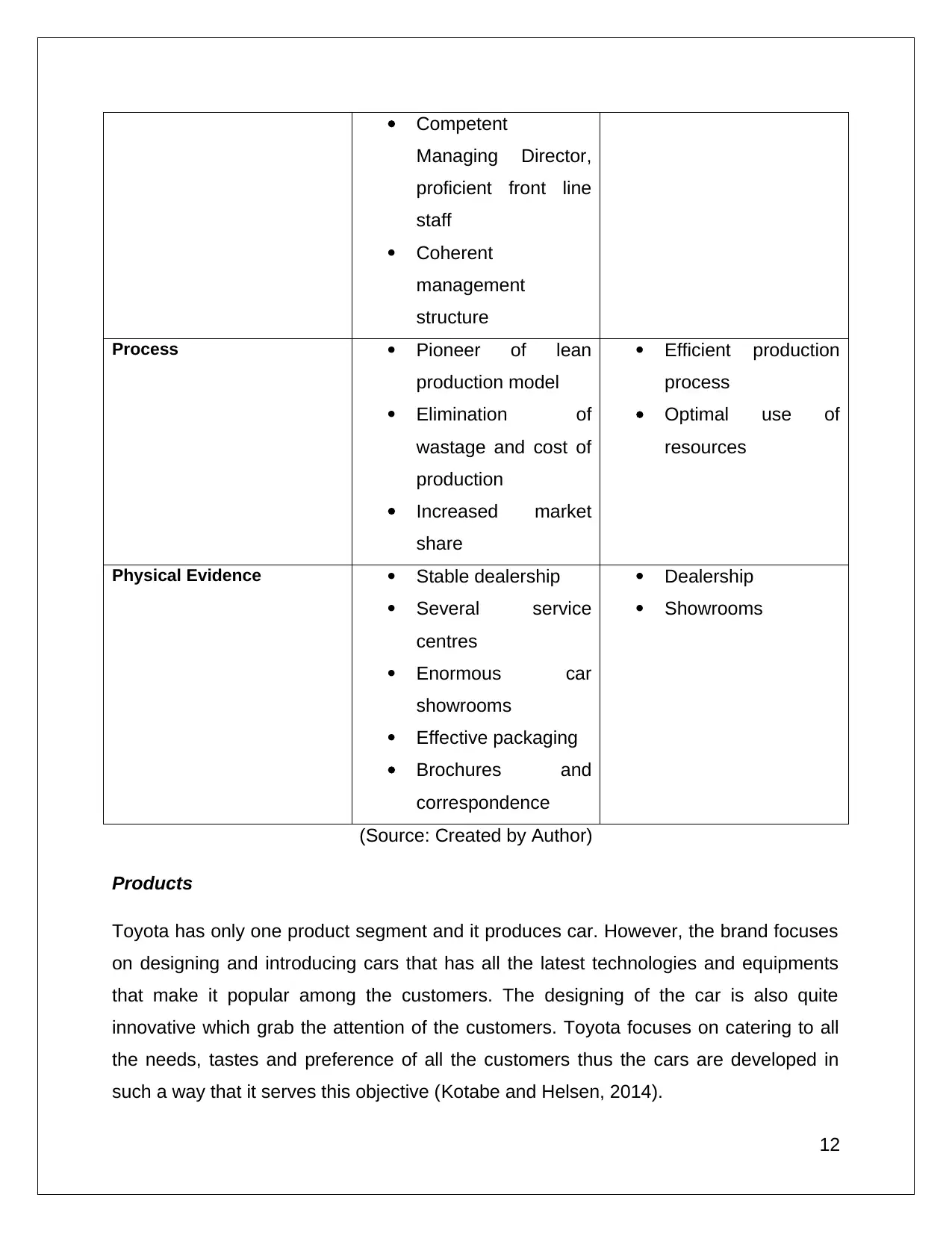
Competent
Managing Director,
proficient front line
staff
Coherent
management
structure
Process Pioneer of lean
production model
Elimination of
wastage and cost of
production
Increased market
share
Efficient production
process
Optimal use of
resources
Physical Evidence Stable dealership
Several service
centres
Enormous car
showrooms
Effective packaging
Brochures and
correspondence
Dealership
Showrooms
(Source: Created by Author)
Products
Toyota has only one product segment and it produces car. However, the brand focuses
on designing and introducing cars that has all the latest technologies and equipments
that make it popular among the customers. The designing of the car is also quite
innovative which grab the attention of the customers. Toyota focuses on catering to all
the needs, tastes and preference of all the customers thus the cars are developed in
such a way that it serves this objective (Kotabe and Helsen, 2014).
12
Managing Director,
proficient front line
staff
Coherent
management
structure
Process Pioneer of lean
production model
Elimination of
wastage and cost of
production
Increased market
share
Efficient production
process
Optimal use of
resources
Physical Evidence Stable dealership
Several service
centres
Enormous car
showrooms
Effective packaging
Brochures and
correspondence
Dealership
Showrooms
(Source: Created by Author)
Products
Toyota has only one product segment and it produces car. However, the brand focuses
on designing and introducing cars that has all the latest technologies and equipments
that make it popular among the customers. The designing of the car is also quite
innovative which grab the attention of the customers. Toyota focuses on catering to all
the needs, tastes and preference of all the customers thus the cars are developed in
such a way that it serves this objective (Kotabe and Helsen, 2014).
12
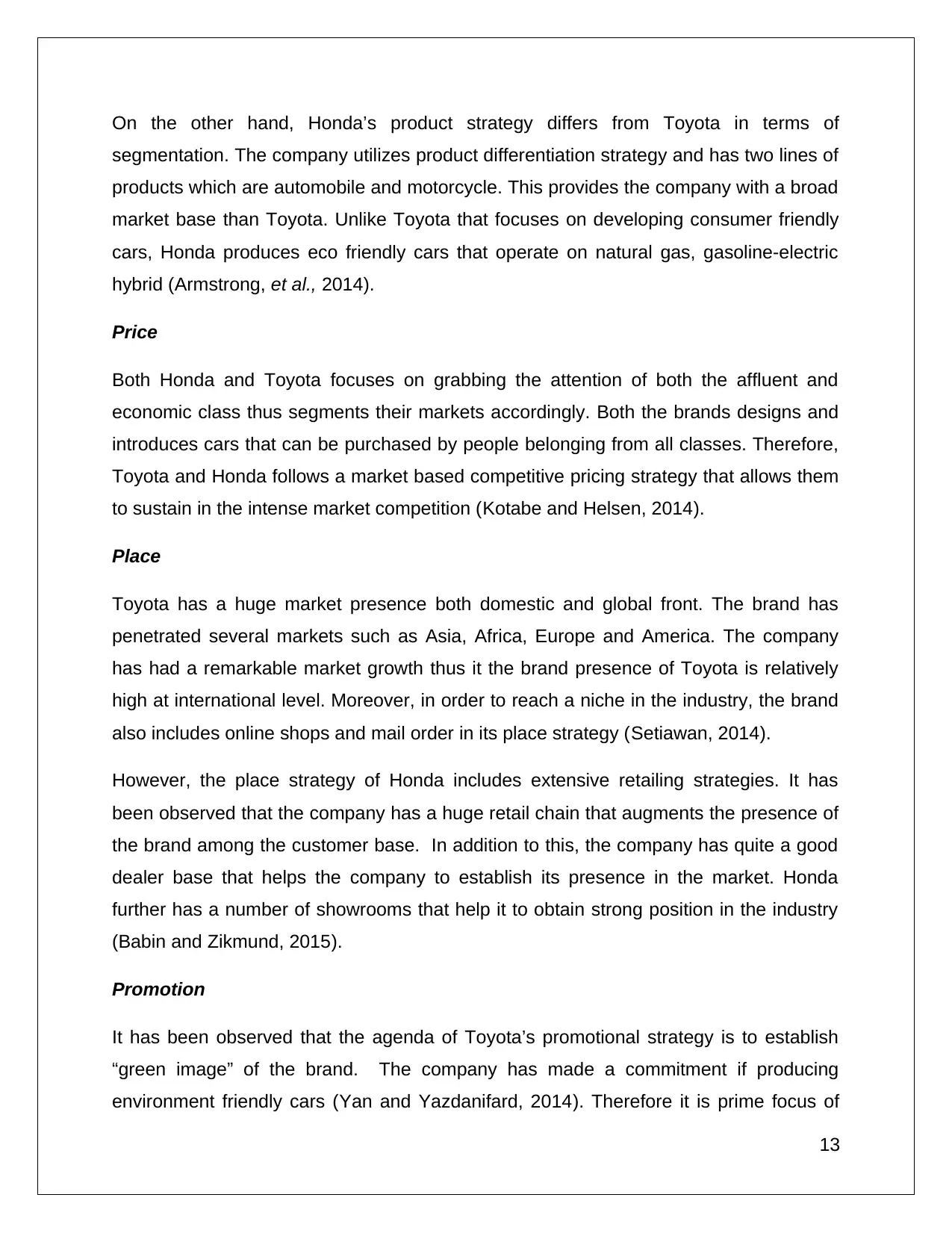
On the other hand, Honda’s product strategy differs from Toyota in terms of
segmentation. The company utilizes product differentiation strategy and has two lines of
products which are automobile and motorcycle. This provides the company with a broad
market base than Toyota. Unlike Toyota that focuses on developing consumer friendly
cars, Honda produces eco friendly cars that operate on natural gas, gasoline-electric
hybrid (Armstrong, et al., 2014).
Price
Both Honda and Toyota focuses on grabbing the attention of both the affluent and
economic class thus segments their markets accordingly. Both the brands designs and
introduces cars that can be purchased by people belonging from all classes. Therefore,
Toyota and Honda follows a market based competitive pricing strategy that allows them
to sustain in the intense market competition (Kotabe and Helsen, 2014).
Place
Toyota has a huge market presence both domestic and global front. The brand has
penetrated several markets such as Asia, Africa, Europe and America. The company
has had a remarkable market growth thus it the brand presence of Toyota is relatively
high at international level. Moreover, in order to reach a niche in the industry, the brand
also includes online shops and mail order in its place strategy (Setiawan, 2014).
However, the place strategy of Honda includes extensive retailing strategies. It has
been observed that the company has a huge retail chain that augments the presence of
the brand among the customer base. In addition to this, the company has quite a good
dealer base that helps the company to establish its presence in the market. Honda
further has a number of showrooms that help it to obtain strong position in the industry
(Babin and Zikmund, 2015).
Promotion
It has been observed that the agenda of Toyota’s promotional strategy is to establish
“green image” of the brand. The company has made a commitment if producing
environment friendly cars (Yan and Yazdanifard, 2014). Therefore it is prime focus of
13
segmentation. The company utilizes product differentiation strategy and has two lines of
products which are automobile and motorcycle. This provides the company with a broad
market base than Toyota. Unlike Toyota that focuses on developing consumer friendly
cars, Honda produces eco friendly cars that operate on natural gas, gasoline-electric
hybrid (Armstrong, et al., 2014).
Price
Both Honda and Toyota focuses on grabbing the attention of both the affluent and
economic class thus segments their markets accordingly. Both the brands designs and
introduces cars that can be purchased by people belonging from all classes. Therefore,
Toyota and Honda follows a market based competitive pricing strategy that allows them
to sustain in the intense market competition (Kotabe and Helsen, 2014).
Place
Toyota has a huge market presence both domestic and global front. The brand has
penetrated several markets such as Asia, Africa, Europe and America. The company
has had a remarkable market growth thus it the brand presence of Toyota is relatively
high at international level. Moreover, in order to reach a niche in the industry, the brand
also includes online shops and mail order in its place strategy (Setiawan, 2014).
However, the place strategy of Honda includes extensive retailing strategies. It has
been observed that the company has a huge retail chain that augments the presence of
the brand among the customer base. In addition to this, the company has quite a good
dealer base that helps the company to establish its presence in the market. Honda
further has a number of showrooms that help it to obtain strong position in the industry
(Babin and Zikmund, 2015).
Promotion
It has been observed that the agenda of Toyota’s promotional strategy is to establish
“green image” of the brand. The company has made a commitment if producing
environment friendly cars (Yan and Yazdanifard, 2014). Therefore it is prime focus of
13
Paraphrase This Document
Need a fresh take? Get an instant paraphrase of this document with our AI Paraphraser
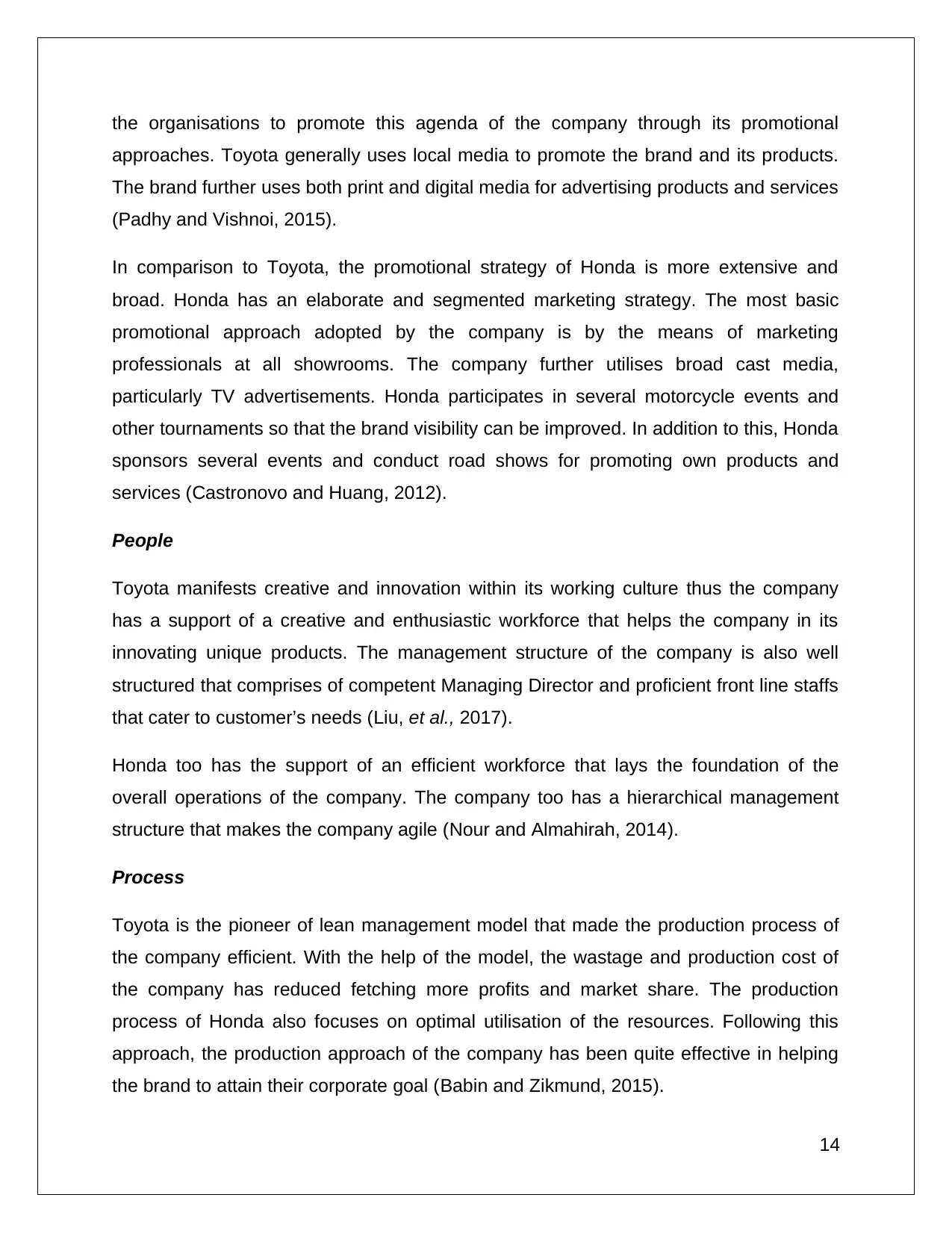
the organisations to promote this agenda of the company through its promotional
approaches. Toyota generally uses local media to promote the brand and its products.
The brand further uses both print and digital media for advertising products and services
(Padhy and Vishnoi, 2015).
In comparison to Toyota, the promotional strategy of Honda is more extensive and
broad. Honda has an elaborate and segmented marketing strategy. The most basic
promotional approach adopted by the company is by the means of marketing
professionals at all showrooms. The company further utilises broad cast media,
particularly TV advertisements. Honda participates in several motorcycle events and
other tournaments so that the brand visibility can be improved. In addition to this, Honda
sponsors several events and conduct road shows for promoting own products and
services (Castronovo and Huang, 2012).
People
Toyota manifests creative and innovation within its working culture thus the company
has a support of a creative and enthusiastic workforce that helps the company in its
innovating unique products. The management structure of the company is also well
structured that comprises of competent Managing Director and proficient front line staffs
that cater to customer’s needs (Liu, et al., 2017).
Honda too has the support of an efficient workforce that lays the foundation of the
overall operations of the company. The company too has a hierarchical management
structure that makes the company agile (Nour and Almahirah, 2014).
Process
Toyota is the pioneer of lean management model that made the production process of
the company efficient. With the help of the model, the wastage and production cost of
the company has reduced fetching more profits and market share. The production
process of Honda also focuses on optimal utilisation of the resources. Following this
approach, the production approach of the company has been quite effective in helping
the brand to attain their corporate goal (Babin and Zikmund, 2015).
14
approaches. Toyota generally uses local media to promote the brand and its products.
The brand further uses both print and digital media for advertising products and services
(Padhy and Vishnoi, 2015).
In comparison to Toyota, the promotional strategy of Honda is more extensive and
broad. Honda has an elaborate and segmented marketing strategy. The most basic
promotional approach adopted by the company is by the means of marketing
professionals at all showrooms. The company further utilises broad cast media,
particularly TV advertisements. Honda participates in several motorcycle events and
other tournaments so that the brand visibility can be improved. In addition to this, Honda
sponsors several events and conduct road shows for promoting own products and
services (Castronovo and Huang, 2012).
People
Toyota manifests creative and innovation within its working culture thus the company
has a support of a creative and enthusiastic workforce that helps the company in its
innovating unique products. The management structure of the company is also well
structured that comprises of competent Managing Director and proficient front line staffs
that cater to customer’s needs (Liu, et al., 2017).
Honda too has the support of an efficient workforce that lays the foundation of the
overall operations of the company. The company too has a hierarchical management
structure that makes the company agile (Nour and Almahirah, 2014).
Process
Toyota is the pioneer of lean management model that made the production process of
the company efficient. With the help of the model, the wastage and production cost of
the company has reduced fetching more profits and market share. The production
process of Honda also focuses on optimal utilisation of the resources. Following this
approach, the production approach of the company has been quite effective in helping
the brand to attain their corporate goal (Babin and Zikmund, 2015).
14
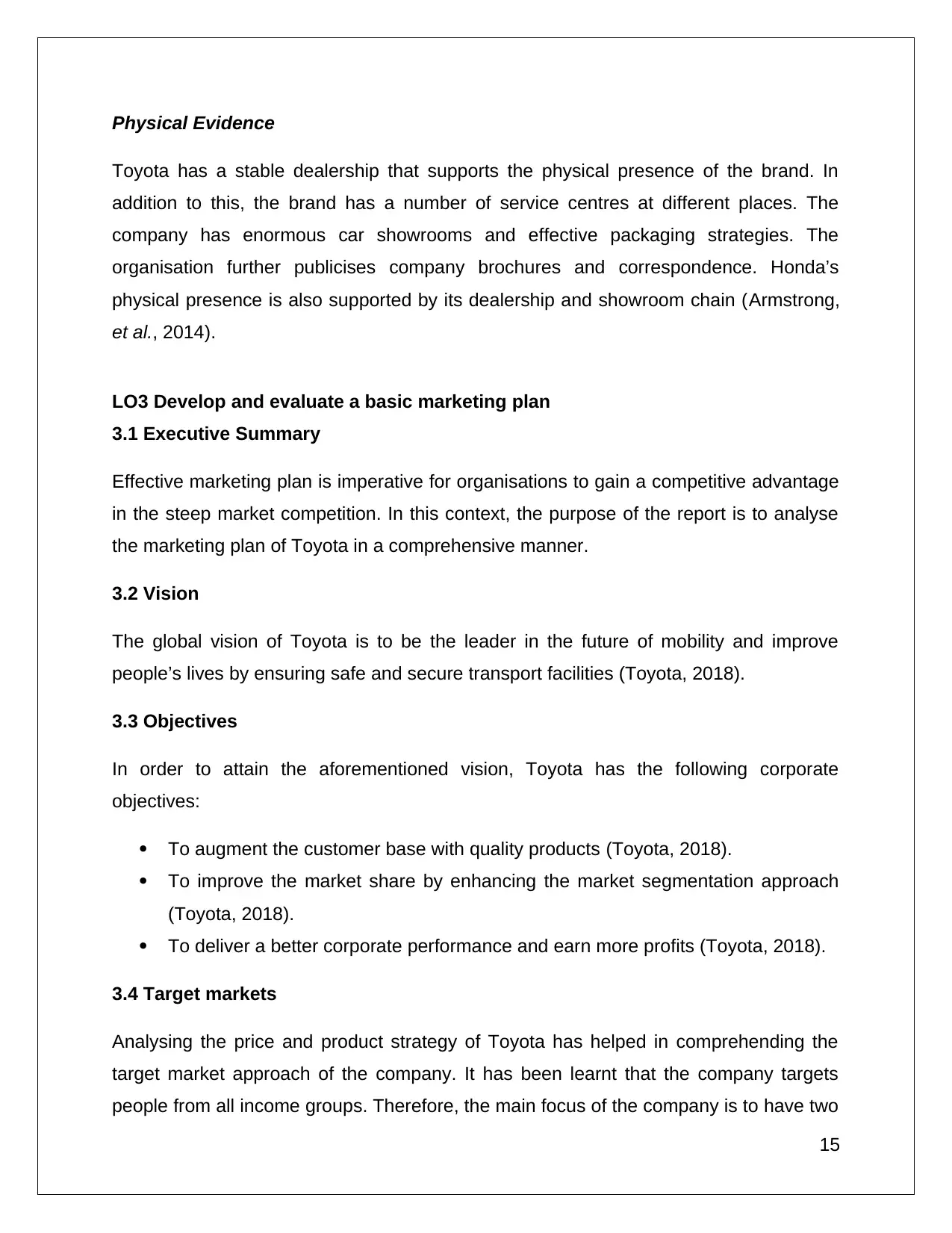
Physical Evidence
Toyota has a stable dealership that supports the physical presence of the brand. In
addition to this, the brand has a number of service centres at different places. The
company has enormous car showrooms and effective packaging strategies. The
organisation further publicises company brochures and correspondence. Honda’s
physical presence is also supported by its dealership and showroom chain (Armstrong,
et al., 2014).
LO3 Develop and evaluate a basic marketing plan
3.1 Executive Summary
Effective marketing plan is imperative for organisations to gain a competitive advantage
in the steep market competition. In this context, the purpose of the report is to analyse
the marketing plan of Toyota in a comprehensive manner.
3.2 Vision
The global vision of Toyota is to be the leader in the future of mobility and improve
people’s lives by ensuring safe and secure transport facilities (Toyota, 2018).
3.3 Objectives
In order to attain the aforementioned vision, Toyota has the following corporate
objectives:
To augment the customer base with quality products (Toyota, 2018).
To improve the market share by enhancing the market segmentation approach
(Toyota, 2018).
To deliver a better corporate performance and earn more profits (Toyota, 2018).
3.4 Target markets
Analysing the price and product strategy of Toyota has helped in comprehending the
target market approach of the company. It has been learnt that the company targets
people from all income groups. Therefore, the main focus of the company is to have two
15
Toyota has a stable dealership that supports the physical presence of the brand. In
addition to this, the brand has a number of service centres at different places. The
company has enormous car showrooms and effective packaging strategies. The
organisation further publicises company brochures and correspondence. Honda’s
physical presence is also supported by its dealership and showroom chain (Armstrong,
et al., 2014).
LO3 Develop and evaluate a basic marketing plan
3.1 Executive Summary
Effective marketing plan is imperative for organisations to gain a competitive advantage
in the steep market competition. In this context, the purpose of the report is to analyse
the marketing plan of Toyota in a comprehensive manner.
3.2 Vision
The global vision of Toyota is to be the leader in the future of mobility and improve
people’s lives by ensuring safe and secure transport facilities (Toyota, 2018).
3.3 Objectives
In order to attain the aforementioned vision, Toyota has the following corporate
objectives:
To augment the customer base with quality products (Toyota, 2018).
To improve the market share by enhancing the market segmentation approach
(Toyota, 2018).
To deliver a better corporate performance and earn more profits (Toyota, 2018).
3.4 Target markets
Analysing the price and product strategy of Toyota has helped in comprehending the
target market approach of the company. It has been learnt that the company targets
people from all income groups. Therefore, the main focus of the company is to have two
15
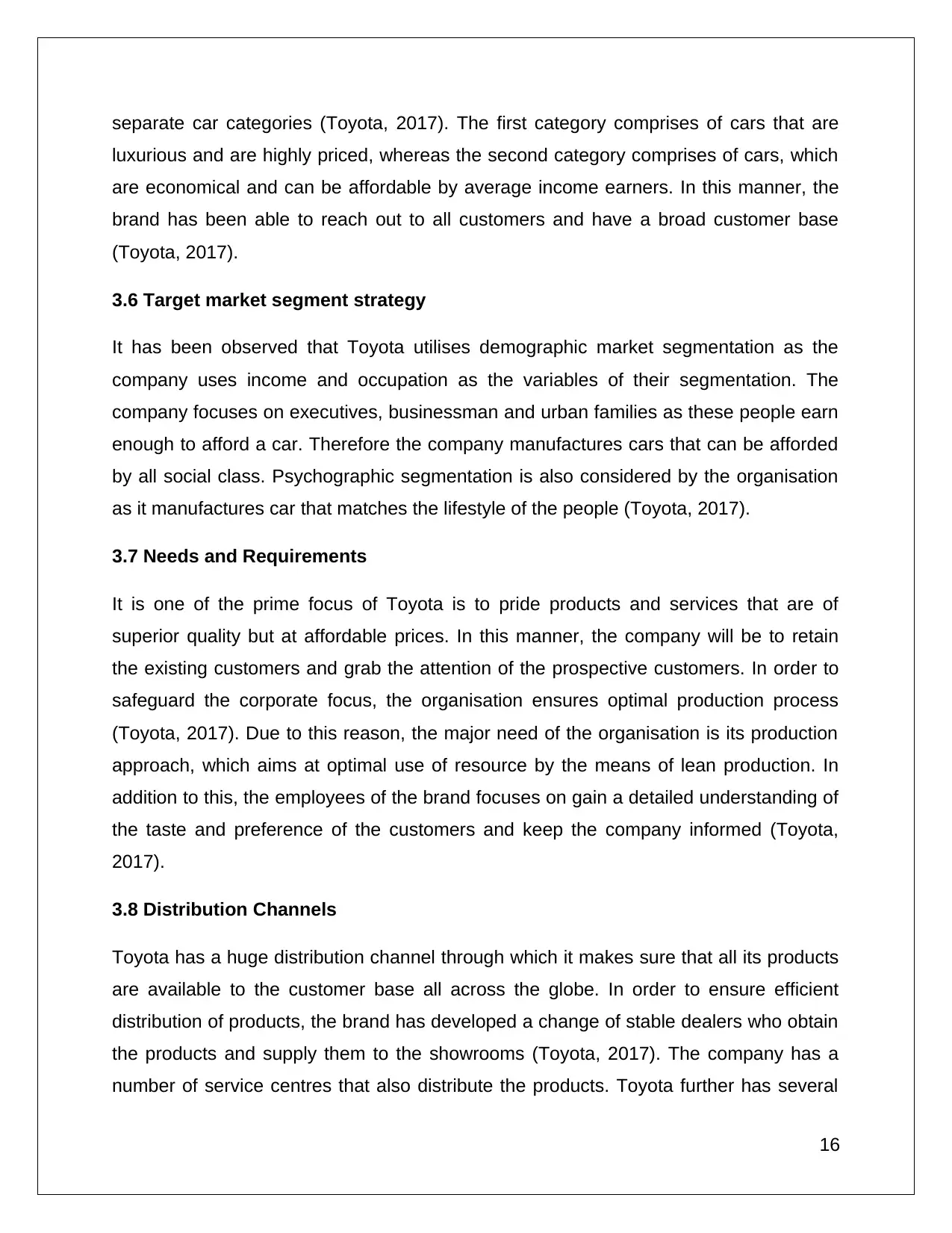
separate car categories (Toyota, 2017). The first category comprises of cars that are
luxurious and are highly priced, whereas the second category comprises of cars, which
are economical and can be affordable by average income earners. In this manner, the
brand has been able to reach out to all customers and have a broad customer base
(Toyota, 2017).
3.6 Target market segment strategy
It has been observed that Toyota utilises demographic market segmentation as the
company uses income and occupation as the variables of their segmentation. The
company focuses on executives, businessman and urban families as these people earn
enough to afford a car. Therefore the company manufactures cars that can be afforded
by all social class. Psychographic segmentation is also considered by the organisation
as it manufactures car that matches the lifestyle of the people (Toyota, 2017).
3.7 Needs and Requirements
It is one of the prime focus of Toyota is to pride products and services that are of
superior quality but at affordable prices. In this manner, the company will be to retain
the existing customers and grab the attention of the prospective customers. In order to
safeguard the corporate focus, the organisation ensures optimal production process
(Toyota, 2017). Due to this reason, the major need of the organisation is its production
approach, which aims at optimal use of resource by the means of lean production. In
addition to this, the employees of the brand focuses on gain a detailed understanding of
the taste and preference of the customers and keep the company informed (Toyota,
2017).
3.8 Distribution Channels
Toyota has a huge distribution channel through which it makes sure that all its products
are available to the customer base all across the globe. In order to ensure efficient
distribution of products, the brand has developed a change of stable dealers who obtain
the products and supply them to the showrooms (Toyota, 2017). The company has a
number of service centres that also distribute the products. Toyota further has several
16
luxurious and are highly priced, whereas the second category comprises of cars, which
are economical and can be affordable by average income earners. In this manner, the
brand has been able to reach out to all customers and have a broad customer base
(Toyota, 2017).
3.6 Target market segment strategy
It has been observed that Toyota utilises demographic market segmentation as the
company uses income and occupation as the variables of their segmentation. The
company focuses on executives, businessman and urban families as these people earn
enough to afford a car. Therefore the company manufactures cars that can be afforded
by all social class. Psychographic segmentation is also considered by the organisation
as it manufactures car that matches the lifestyle of the people (Toyota, 2017).
3.7 Needs and Requirements
It is one of the prime focus of Toyota is to pride products and services that are of
superior quality but at affordable prices. In this manner, the company will be to retain
the existing customers and grab the attention of the prospective customers. In order to
safeguard the corporate focus, the organisation ensures optimal production process
(Toyota, 2017). Due to this reason, the major need of the organisation is its production
approach, which aims at optimal use of resource by the means of lean production. In
addition to this, the employees of the brand focuses on gain a detailed understanding of
the taste and preference of the customers and keep the company informed (Toyota,
2017).
3.8 Distribution Channels
Toyota has a huge distribution channel through which it makes sure that all its products
are available to the customer base all across the globe. In order to ensure efficient
distribution of products, the brand has developed a change of stable dealers who obtain
the products and supply them to the showrooms (Toyota, 2017). The company has a
number of service centres that also distribute the products. Toyota further has several
16
Secure Best Marks with AI Grader
Need help grading? Try our AI Grader for instant feedback on your assignments.
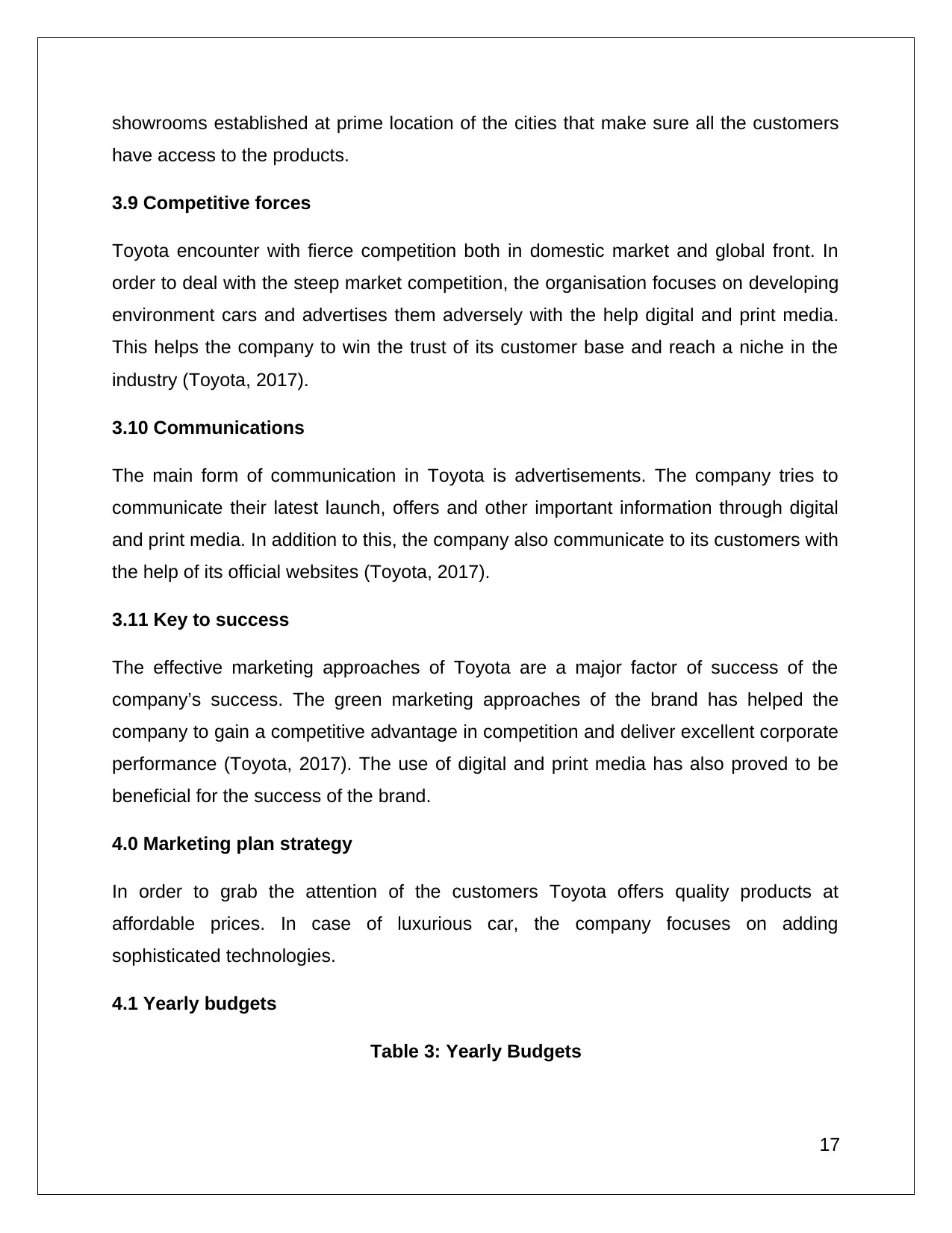
showrooms established at prime location of the cities that make sure all the customers
have access to the products.
3.9 Competitive forces
Toyota encounter with fierce competition both in domestic market and global front. In
order to deal with the steep market competition, the organisation focuses on developing
environment cars and advertises them adversely with the help digital and print media.
This helps the company to win the trust of its customer base and reach a niche in the
industry (Toyota, 2017).
3.10 Communications
The main form of communication in Toyota is advertisements. The company tries to
communicate their latest launch, offers and other important information through digital
and print media. In addition to this, the company also communicate to its customers with
the help of its official websites (Toyota, 2017).
3.11 Key to success
The effective marketing approaches of Toyota are a major factor of success of the
company’s success. The green marketing approaches of the brand has helped the
company to gain a competitive advantage in competition and deliver excellent corporate
performance (Toyota, 2017). The use of digital and print media has also proved to be
beneficial for the success of the brand.
4.0 Marketing plan strategy
In order to grab the attention of the customers Toyota offers quality products at
affordable prices. In case of luxurious car, the company focuses on adding
sophisticated technologies.
4.1 Yearly budgets
Table 3: Yearly Budgets
17
have access to the products.
3.9 Competitive forces
Toyota encounter with fierce competition both in domestic market and global front. In
order to deal with the steep market competition, the organisation focuses on developing
environment cars and advertises them adversely with the help digital and print media.
This helps the company to win the trust of its customer base and reach a niche in the
industry (Toyota, 2017).
3.10 Communications
The main form of communication in Toyota is advertisements. The company tries to
communicate their latest launch, offers and other important information through digital
and print media. In addition to this, the company also communicate to its customers with
the help of its official websites (Toyota, 2017).
3.11 Key to success
The effective marketing approaches of Toyota are a major factor of success of the
company’s success. The green marketing approaches of the brand has helped the
company to gain a competitive advantage in competition and deliver excellent corporate
performance (Toyota, 2017). The use of digital and print media has also proved to be
beneficial for the success of the brand.
4.0 Marketing plan strategy
In order to grab the attention of the customers Toyota offers quality products at
affordable prices. In case of luxurious car, the company focuses on adding
sophisticated technologies.
4.1 Yearly budgets
Table 3: Yearly Budgets
17
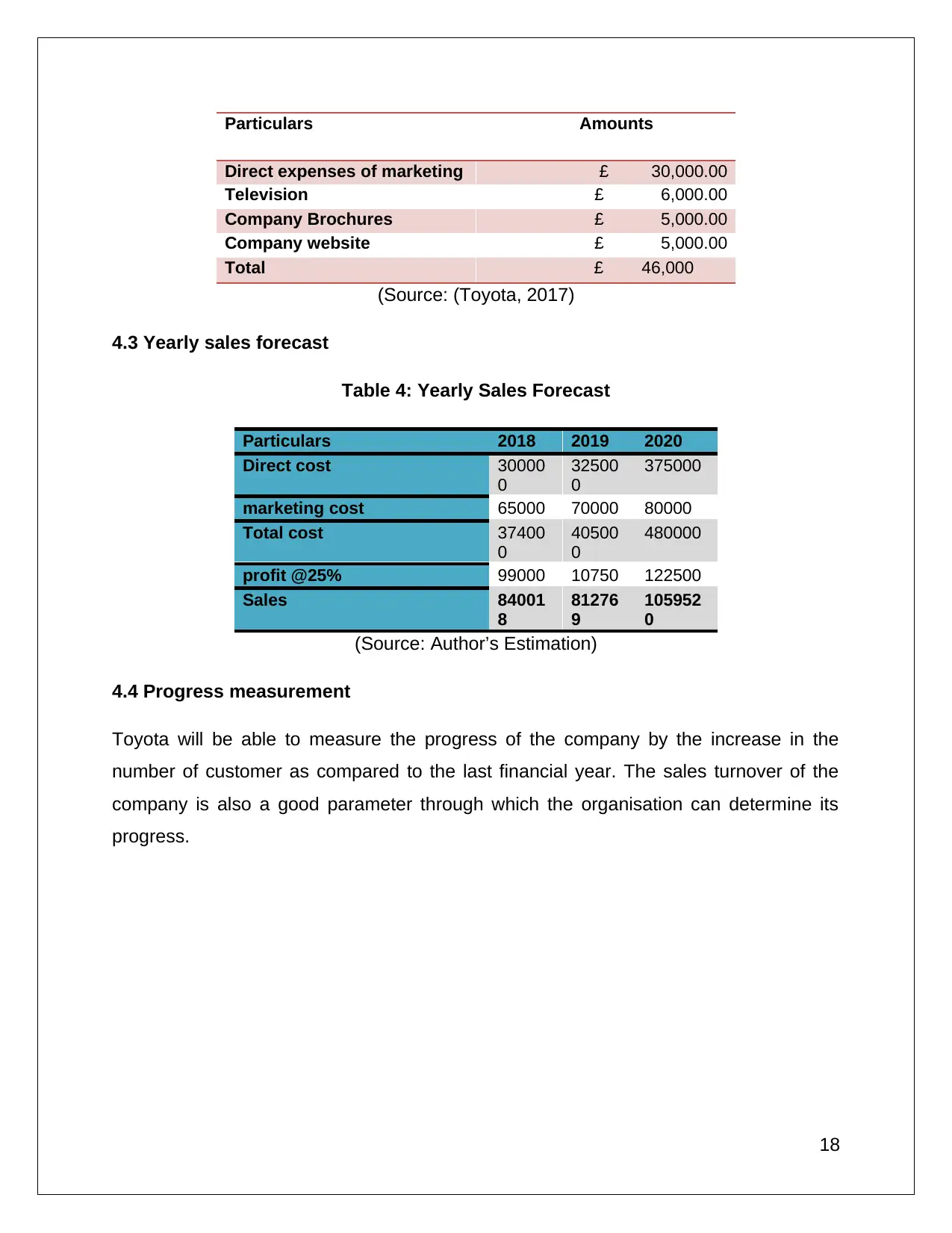
Particulars Amounts
Direct expenses of marketing £ 30,000.00
Television £ 6,000.00
Company Brochures £ 5,000.00
Company website £ 5,000.00
Total £ 46,000
(Source: (Toyota, 2017)
4.3 Yearly sales forecast
Table 4: Yearly Sales Forecast
Particulars 2018 2019 2020
Direct cost 30000
0
32500
0
375000
marketing cost 65000 70000 80000
Total cost 37400
0
40500
0
480000
profit @25% 99000 10750 122500
Sales 84001
8
81276
9
105952
0
(Source: Author’s Estimation)
4.4 Progress measurement
Toyota will be able to measure the progress of the company by the increase in the
number of customer as compared to the last financial year. The sales turnover of the
company is also a good parameter through which the organisation can determine its
progress.
18
Direct expenses of marketing £ 30,000.00
Television £ 6,000.00
Company Brochures £ 5,000.00
Company website £ 5,000.00
Total £ 46,000
(Source: (Toyota, 2017)
4.3 Yearly sales forecast
Table 4: Yearly Sales Forecast
Particulars 2018 2019 2020
Direct cost 30000
0
32500
0
375000
marketing cost 65000 70000 80000
Total cost 37400
0
40500
0
480000
profit @25% 99000 10750 122500
Sales 84001
8
81276
9
105952
0
(Source: Author’s Estimation)
4.4 Progress measurement
Toyota will be able to measure the progress of the company by the increase in the
number of customer as compared to the last financial year. The sales turnover of the
company is also a good parameter through which the organisation can determine its
progress.
18
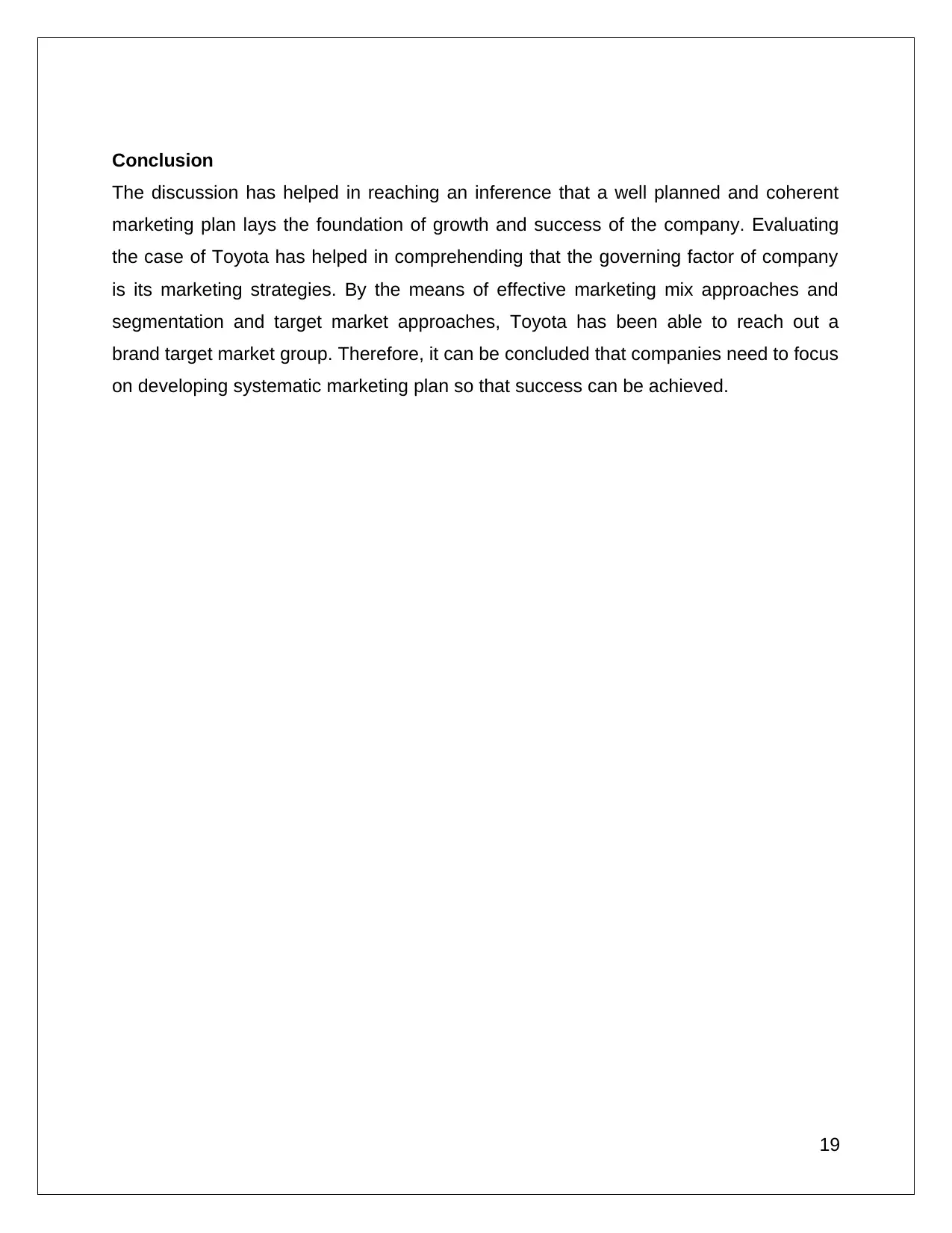
Conclusion
The discussion has helped in reaching an inference that a well planned and coherent
marketing plan lays the foundation of growth and success of the company. Evaluating
the case of Toyota has helped in comprehending that the governing factor of company
is its marketing strategies. By the means of effective marketing mix approaches and
segmentation and target market approaches, Toyota has been able to reach out a
brand target market group. Therefore, it can be concluded that companies need to focus
on developing systematic marketing plan so that success can be achieved.
19
The discussion has helped in reaching an inference that a well planned and coherent
marketing plan lays the foundation of growth and success of the company. Evaluating
the case of Toyota has helped in comprehending that the governing factor of company
is its marketing strategies. By the means of effective marketing mix approaches and
segmentation and target market approaches, Toyota has been able to reach out a
brand target market group. Therefore, it can be concluded that companies need to focus
on developing systematic marketing plan so that success can be achieved.
19
Paraphrase This Document
Need a fresh take? Get an instant paraphrase of this document with our AI Paraphraser
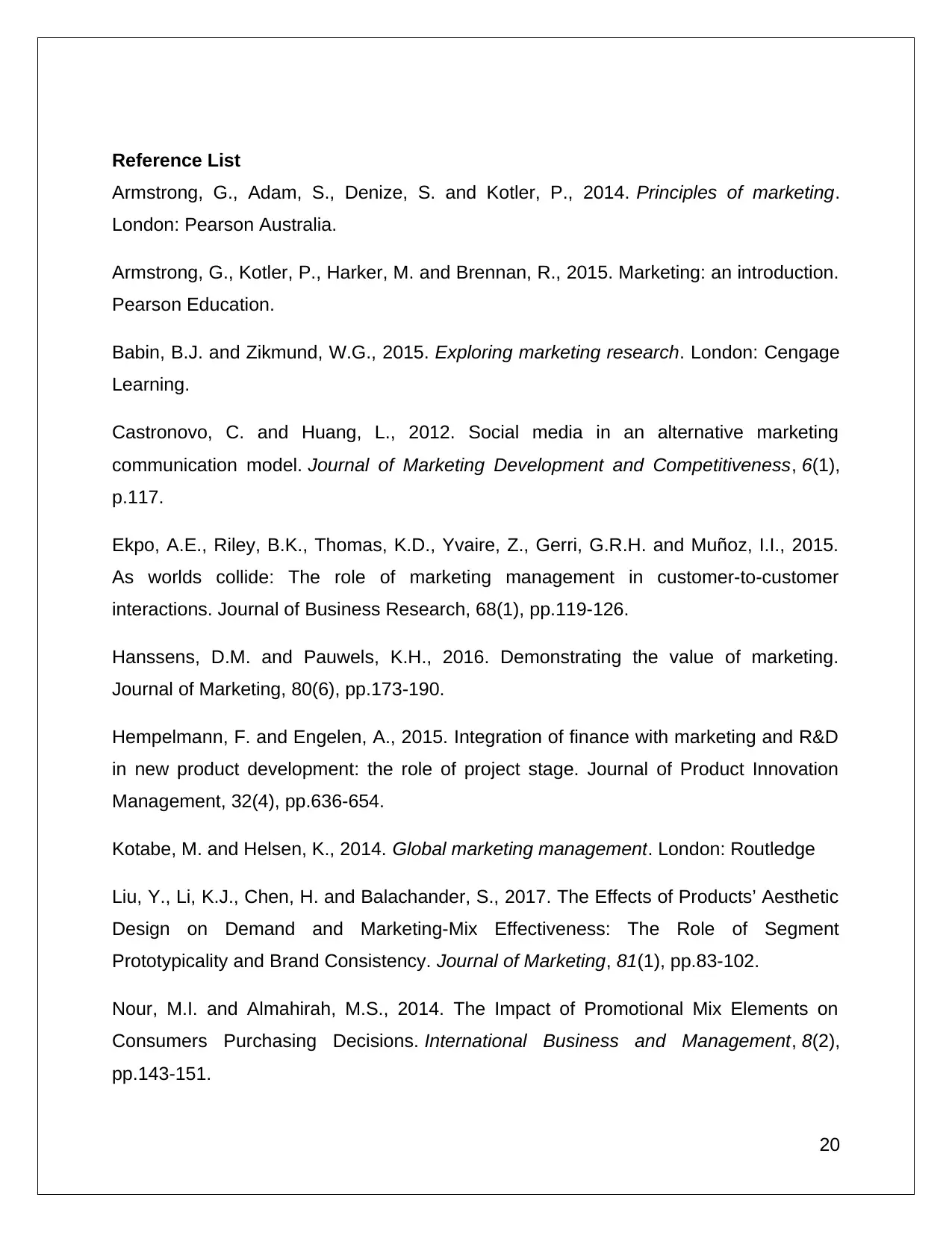
Reference List
Armstrong, G., Adam, S., Denize, S. and Kotler, P., 2014. Principles of marketing.
London: Pearson Australia.
Armstrong, G., Kotler, P., Harker, M. and Brennan, R., 2015. Marketing: an introduction.
Pearson Education.
Babin, B.J. and Zikmund, W.G., 2015. Exploring marketing research. London: Cengage
Learning.
Castronovo, C. and Huang, L., 2012. Social media in an alternative marketing
communication model. Journal of Marketing Development and Competitiveness, 6(1),
p.117.
Ekpo, A.E., Riley, B.K., Thomas, K.D., Yvaire, Z., Gerri, G.R.H. and Muñoz, I.I., 2015.
As worlds collide: The role of marketing management in customer-to-customer
interactions. Journal of Business Research, 68(1), pp.119-126.
Hanssens, D.M. and Pauwels, K.H., 2016. Demonstrating the value of marketing.
Journal of Marketing, 80(6), pp.173-190.
Hempelmann, F. and Engelen, A., 2015. Integration of finance with marketing and R&D
in new product development: the role of project stage. Journal of Product Innovation
Management, 32(4), pp.636-654.
Kotabe, M. and Helsen, K., 2014. Global marketing management. London: Routledge
Liu, Y., Li, K.J., Chen, H. and Balachander, S., 2017. The Effects of Products’ Aesthetic
Design on Demand and Marketing-Mix Effectiveness: The Role of Segment
Prototypicality and Brand Consistency. Journal of Marketing, 81(1), pp.83-102.
Nour, M.I. and Almahirah, M.S., 2014. The Impact of Promotional Mix Elements on
Consumers Purchasing Decisions. International Business and Management, 8(2),
pp.143-151.
20
Armstrong, G., Adam, S., Denize, S. and Kotler, P., 2014. Principles of marketing.
London: Pearson Australia.
Armstrong, G., Kotler, P., Harker, M. and Brennan, R., 2015. Marketing: an introduction.
Pearson Education.
Babin, B.J. and Zikmund, W.G., 2015. Exploring marketing research. London: Cengage
Learning.
Castronovo, C. and Huang, L., 2012. Social media in an alternative marketing
communication model. Journal of Marketing Development and Competitiveness, 6(1),
p.117.
Ekpo, A.E., Riley, B.K., Thomas, K.D., Yvaire, Z., Gerri, G.R.H. and Muñoz, I.I., 2015.
As worlds collide: The role of marketing management in customer-to-customer
interactions. Journal of Business Research, 68(1), pp.119-126.
Hanssens, D.M. and Pauwels, K.H., 2016. Demonstrating the value of marketing.
Journal of Marketing, 80(6), pp.173-190.
Hempelmann, F. and Engelen, A., 2015. Integration of finance with marketing and R&D
in new product development: the role of project stage. Journal of Product Innovation
Management, 32(4), pp.636-654.
Kotabe, M. and Helsen, K., 2014. Global marketing management. London: Routledge
Liu, Y., Li, K.J., Chen, H. and Balachander, S., 2017. The Effects of Products’ Aesthetic
Design on Demand and Marketing-Mix Effectiveness: The Role of Segment
Prototypicality and Brand Consistency. Journal of Marketing, 81(1), pp.83-102.
Nour, M.I. and Almahirah, M.S., 2014. The Impact of Promotional Mix Elements on
Consumers Purchasing Decisions. International Business and Management, 8(2),
pp.143-151.
20
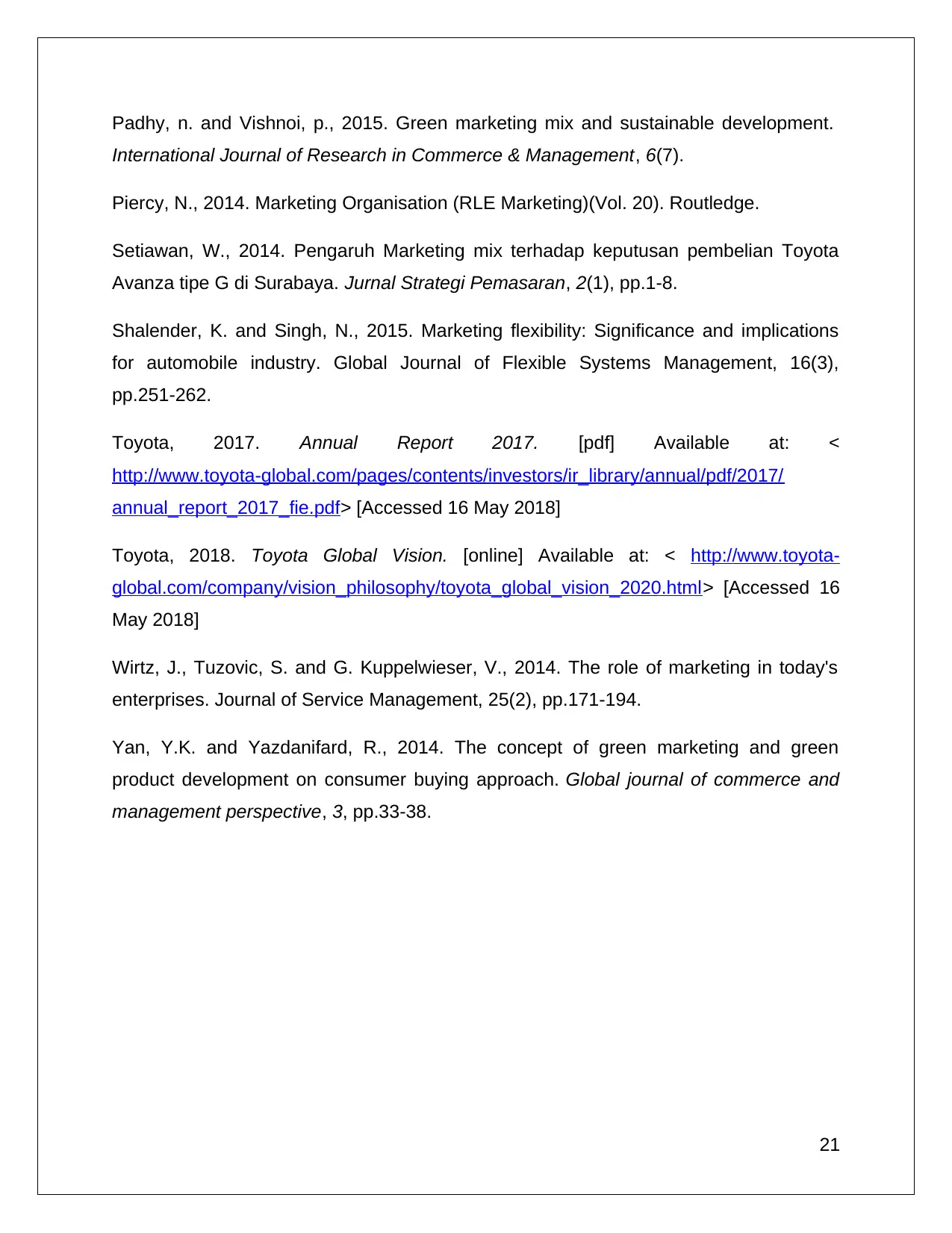
Padhy, n. and Vishnoi, p., 2015. Green marketing mix and sustainable development.
International Journal of Research in Commerce & Management, 6(7).
Piercy, N., 2014. Marketing Organisation (RLE Marketing)(Vol. 20). Routledge.
Setiawan, W., 2014. Pengaruh Marketing mix terhadap keputusan pembelian Toyota
Avanza tipe G di Surabaya. Jurnal Strategi Pemasaran, 2(1), pp.1-8.
Shalender, K. and Singh, N., 2015. Marketing flexibility: Significance and implications
for automobile industry. Global Journal of Flexible Systems Management, 16(3),
pp.251-262.
Toyota, 2017. Annual Report 2017. [pdf] Available at: <
http://www.toyota-global.com/pages/contents/investors/ir_library/annual/pdf/2017/
annual_report_2017_fie.pdf> [Accessed 16 May 2018]
Toyota, 2018. Toyota Global Vision. [online] Available at: < http://www.toyota-
global.com/company/vision_philosophy/toyota_global_vision_2020.html> [Accessed 16
May 2018]
Wirtz, J., Tuzovic, S. and G. Kuppelwieser, V., 2014. The role of marketing in today's
enterprises. Journal of Service Management, 25(2), pp.171-194.
Yan, Y.K. and Yazdanifard, R., 2014. The concept of green marketing and green
product development on consumer buying approach. Global journal of commerce and
management perspective, 3, pp.33-38.
21
International Journal of Research in Commerce & Management, 6(7).
Piercy, N., 2014. Marketing Organisation (RLE Marketing)(Vol. 20). Routledge.
Setiawan, W., 2014. Pengaruh Marketing mix terhadap keputusan pembelian Toyota
Avanza tipe G di Surabaya. Jurnal Strategi Pemasaran, 2(1), pp.1-8.
Shalender, K. and Singh, N., 2015. Marketing flexibility: Significance and implications
for automobile industry. Global Journal of Flexible Systems Management, 16(3),
pp.251-262.
Toyota, 2017. Annual Report 2017. [pdf] Available at: <
http://www.toyota-global.com/pages/contents/investors/ir_library/annual/pdf/2017/
annual_report_2017_fie.pdf> [Accessed 16 May 2018]
Toyota, 2018. Toyota Global Vision. [online] Available at: < http://www.toyota-
global.com/company/vision_philosophy/toyota_global_vision_2020.html> [Accessed 16
May 2018]
Wirtz, J., Tuzovic, S. and G. Kuppelwieser, V., 2014. The role of marketing in today's
enterprises. Journal of Service Management, 25(2), pp.171-194.
Yan, Y.K. and Yazdanifard, R., 2014. The concept of green marketing and green
product development on consumer buying approach. Global journal of commerce and
management perspective, 3, pp.33-38.
21
1 out of 21
Related Documents
Your All-in-One AI-Powered Toolkit for Academic Success.
+13062052269
info@desklib.com
Available 24*7 on WhatsApp / Email
![[object Object]](/_next/static/media/star-bottom.7253800d.svg)
Unlock your academic potential
© 2024 | Zucol Services PVT LTD | All rights reserved.





